ZTE Z852 LTE/WCDMA/GSM(GPRS) Multi-Mode Digital Mobile Phone User Manual
ZTE Corporation LTE/WCDMA/GSM(GPRS) Multi-Mode Digital Mobile Phone
ZTE >
User manual
1
Z852
User Manual

2
About This Manual
Thank you for choosing this ZTE mobile device. In order to keep
your device in its best condition, please read this manual and
keep it for future reference.
Copyright
Copyright © 2017 ZTE CORPORATION
All rights reserved.
No part of this publication may be quoted, reproduced, translated
or used in any form or by any means, electronic or mechanical,
including photocopying and microfilm, without the prior written
permission of ZTE Corporation.
Notice
ZTE Corporation reserves the right to make modifications on print
errors or update specifications in this guide without prior notice.
This manual has been designed with the utmost care to ensure
the accuracy of its content. However, all statements, information
and recommendations contained therein do not constitute a
warranty of any kind, either expressed or implied. Please refer to
For Your Safety to be sure to use your phone properly and safely.
We offer self-service for our smart terminal device users. Please
visit the ZTE official website (at www.zteusa.com) for more
information on self-service and supported product models.
Information on the website takes precedence.
Disclaimer
ZTE Corporation expressly disclaims any liability for faults and

3
damages caused by unauthorized modifications of the software.
Images and screenshots used in this manual may differ from the
actual product. Content in this manual may differ from the actual
product or software.
Trademarks
ZTE and the ZTE logos are trademarks of ZTE Corporation.
Google and Android are trademarks of Google, Inc.
The Bluetooth
®
trademark and logos are owned by the Bluetooth
SIG, Inc. and any use of such trademarks by ZTE Corporation is
under license.
microSDXC Logo is a trademark of SD-3C, LLC.
Qualcomm
®
Snapdragon™ processors are products of
Qualcomm Technologies, Inc.
Qualcomm and Snapdragon are trademarks of Qualcomm
Incorporated, registered in the United States and other countries.
Used with permission.
Other trademarks and trade names are the property of their
respective owners.
Version No.: R1.0
Edition Time: May 15, 2017

4
Contents
Getting Started ....................................................... 10
Getting to Know Your Phone ............................................ 10
Knowing the Keys ............................................................ 12
Installing the nano-SIM Card, the microSDXC™ Card and
the Battery ....................................................................... 13
Charging the Battery ........................................................ 15
Extending the Battery Life ................................................ 17
Powering On/Off .............................................................. 17
Setting Up for the First Time ............................................ 18
Locking/Unlocking the Screen and Keys .......................... 18
Using the Touch Screen ................................................... 19
Getting to Know the Home Screen ................................... 22
Personalizing.......................................................... 25
Changing the System Language ...................................... 25
Setting the Date and Time................................................ 25
Changing Ringtone and Notification Sound ...................... 26
Turning On/Off System Sounds ........................................ 26
Adjusting Volume ............................................................. 26
Switching to Silent or Vibration Mode ............................... 27
Using Do Not Disturb Mode ............................................. 28
Applying New Wallpapers ................................................ 29
Setting the Theme ........................................................... 30
Setting the Home Screen Transition Effect ....................... 30
5
Changing Screen Brightness ............................................ 30
Protecting Your Phone With Screen Locks ........................ 31
Protecting Your Phone With Encryption ............................ 32
Protecting Your Phone With Screen Pinning ..................... 33
Knowing the Basics ............................................... 35
Monitoring the Phone Status ............................................ 35
Managing Notifications ..................................................... 36
Managing Shortcuts and Widgets ..................................... 39
Organizing With Folders ................................................... 40
Rearranging the Primary Shortcuts ................................... 41
Entering Text .................................................................... 41
Editing Text ...................................................................... 51
Opening and Switching Apps ............................................ 52
Using Two Apps in Split-Screen Mode .............................. 53
Uninstalling or Disabling an App ....................................... 54
Connecting to Networks and Devices .................. 55
Connecting to Mobile Networks ........................................ 55
Connecting to Wi-Fi .......................................................... 57
Using Wi-Fi Direct
®
.......................................................... 60
Connecting to Bluetooth Devices ...................................... 61
Connecting to Your Computer via USB ............................. 64
Using the microSDXC Card as Portable or Phone Storage65
Sharing Your Mobile Data Connection .............................. 69
Connecting to Virtual Private Networks ............................. 71
6
Phone Calls ............................................................ 74
Placing and Ending Calls ................................................. 74
Answering or Rejecting Calls ........................................... 75
Working With the Call History ........................................... 76
Calling Your Contacts ....................................................... 78
Checking Voicemail ......................................................... 78
Using Options During a Call ............................................. 79
Managing Multi-party Calls ............................................... 80
Adjusting Your Call Settings ............................................. 81
Contacts .................................................................. 88
Checking Contact Details ................................................. 88
Adding a New Contact ..................................................... 88
Setting Up Your Own Profile ............................................. 89
Importing, Exporting, and Sharing Contacts ..................... 89
Working With Favorite Contacts ....................................... 91
Working With Groups ....................................................... 92
Searching for a Contact ................................................... 94
Editing Contacts............................................................... 94
Web Accounts ........................................................ 96
Adding or Removing Accounts ......................................... 96
Configuring Account Sync ................................................ 97
Email ....................................................................... 99
Setting Up the First Email Account ................................... 99
Checking Your Emails ...................................................... 99
7
Writing and Sending an Email ........................................ 100
Responding to an Email ................................................. 100
Adding and Editing Email Accounts ................................ 102
Changing General Email Settings ................................... 103
Messaging ............................................................ 104
Opening the Messaging Screen ..................................... 104
Sending a Message ....................................................... 104
Replying to a Message ................................................... 105
Forwarding a Message ................................................... 106
Deleting Messages or Threads ....................................... 106
Changing Message Settings ........................................... 107
Calendar ............................................................... 108
Viewing Your Calendars and Events ............................... 108
Creating an Event .......................................................... 109
Editing, Deleting or Sharing an Event ............................. 110
Changing Calendar Settings ........................................... 110
Web Browser ........................................................ 111
Opening the Browser ..................................................... 111
Setting the Homepage .................................................... 111
Using Multiple Browser Tabs .......................................... 112
Downloading Files .......................................................... 112
Changing Browser Settings ............................................ 112
Camera ................................................................. 114
Capturing a Photo .......................................................... 114
8
Recording a Video ......................................................... 116
Using Manual Camera Mode ......................................... 117
Using Other Camera Modes .......................................... 118
Customizing Camera/Camcorder Settings ...................... 118
Gallery ................................................................... 121
Opening Gallery ............................................................. 121
Working With Albums ..................................................... 121
Working With Pictures .................................................... 123
Retouching Your Pictures ............................................... 124
Making a GIF Picture or a Collage ................................. 125
Playing Videos ............................................................... 127
Music ..................................................................... 128
Viewing Your Music Library ............................................ 128
Playing Music ................................................................ 129
Managing Playlists ......................................................... 131
Video Player ......................................................... 132
Opening the Video Library ............................................. 132
Playing and Controlling Videos ...................................... 132
Managing Video Files .................................................... 133
FM Radio ............................................................... 135
Scanning and Saving Channels ..................................... 135
Listening to FM Radio .................................................... 135
Editing a Saved Channel ............................................... 136
Other Options and Settings ............................................ 136
9
Sound Recorder ................................................... 138
Recording a Voice Memo ............................................... 138
Playing a Voice Memo .................................................... 138
More Apps ............................................................ 140
Backup & Restore .......................................................... 140
Calculator ...................................................................... 140
Clock ............................................................................. 140
Downloads ..................................................................... 142
File Manager .................................................................. 142
Google Apps .................................................................. 143
Settings ................................................................ 145
Wireless and Networks ................................................... 145
Device ........................................................................... 148
Personal ........................................................................ 153
System........................................................................... 158
Upgrading the Phone Software .......................... 160
Troubleshooting ................................................... 161
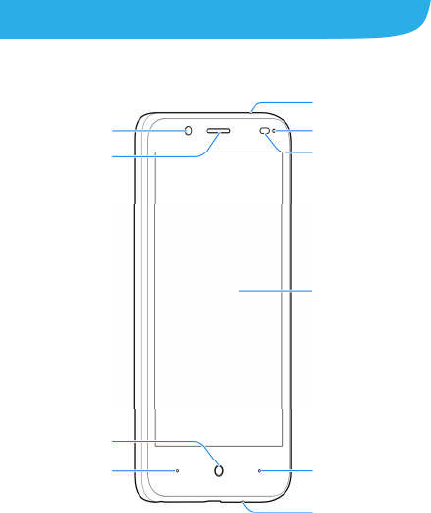
10
Getting Started
Getting to Know Your Phone
Earpiece
Proximity & light
sensor
Back key
Home key
Touch screen
Front camera
Recent apps key
Indicator light
Auxiliary
microphone
Main
microphone
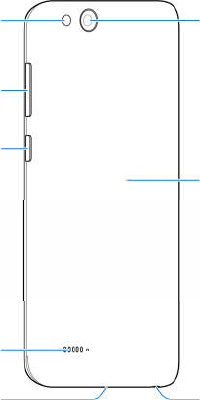
11
Volume
up/down key
Speaker
Charging/
micro-USB p
ort
3.5mm Headset
j
ack
Back camera
Flash
Power key
Back cover

12
Knowing the Keys
Key
Function
Power key
Press and hold to turn on or off airplane
mode, power off or restart the phone.
Press to turn off or on the screen display.
Home key
Touc
h to return to the home screen from any
application or screen.
Touch and hold to use Google Search.
Back key Touch to go to the previous screen.
Recent apps
key Touch to see recently used apps.
Volume key Press or hold either end of the key to turn the
volume up or down.
NOTE:
The positions of the Back key and the Recent apps key are
interchangeable through Settings > Navigation key.

13
Installing the nano-SIM Card, the
microSDXC™ Card and the Battery
The nano-SIM card can be installed or removed while the phone
is turned on. Power off your phone before removing or replacing
the battery.
The microSDXC card (not included) can be installed or removed
while the phone is turned on. You need to unmount the
microSDXC card before removing it. See Using the microSDXC
Card as Portable or Phone Storage.
WARNING!
To avoid damage to the phone, do not use any other kind of SIM
cards, or any non-standard nano-SIM card cut from a SIM card.
You can get a standard nano-SIM card from your service
provider.
1. Insert your fingernail into the slot at the bottom left of the back
cover and lift it up gently.
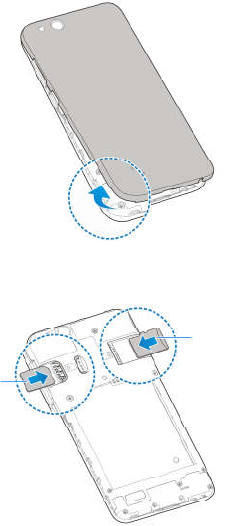
14
2. Hold the nano-SIM card or the microSDXC card with the cut
corner oriented as shown and slip it into the card holder.
microSDXC
card
nano-
SIM
card
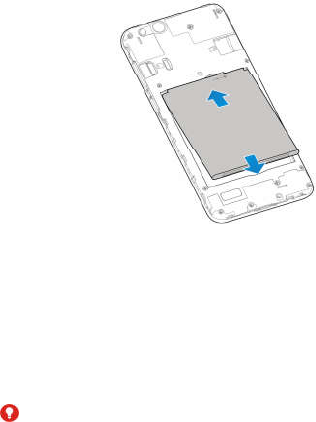
15
3. Insert the battery by aligning the metal contacts on the battery
with the metal contacts in the battery compartment. Gently
push down on the battery until it clicks into place.
4. Align the back cover with the back of the phone and press the
cover back into place. Ensure that all the tabs are secure and
there are no gaps around the cover.
Charging the Battery
Your phone’s battery should have enough power for the phone to
turn on, find a signal, and make a few calls. You should fully
charge the battery as soon as possible.
WARNING!
Use only ZTE-approved chargers and USB cables. The use of
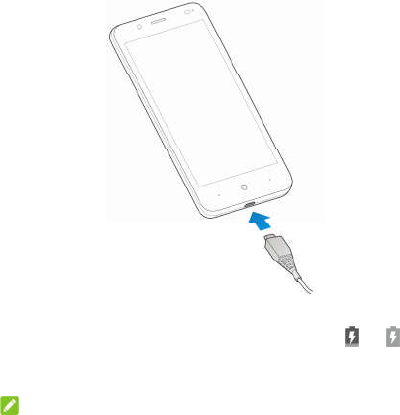
16
unapproved accessories could damage your phone or cause the
battery to explode.
1. Connect the adaptor to the charging jack. Ensure that the
adaptor is inserted with the correct orientation. Do not force
the connector into the charging jack.
2. Connect the charger to a standard AC power outlet. If the
phone is on, you’ll see a charging icon, such as or ,
appear on the status bar.
3. Disconnect the charger when the battery is fully charged.
NOTE:

17
If the battery is extremely low, you may be unable to power on
the phone even when it is being charged. In this case, try again
after charging the phone for at least 20 minutes. Contact the
customer service if you still cannot power on the phone after
prolonged charging.
Extending the Battery Life
Active applications, screen brightness levels, Bluetooth and Wi-Fi
usage and GPS functionality can drain your battery. You can
follow the helpful tips below to conserve your battery power:
Use the Battery saver feature in Settings.
Reduce the screen backlight time.
Lower the screen brightness.
Turn Wi-Fi, Bluetooth and auto-sync off when not in use.
Disable the GPS function when not in use. Most applications
using this function will periodically query the GPS satellites
for your current location, and each query drains your battery.
Powering On/Off
Press and hold the Power key to turn on your phone.
To power off, press and hold the Power key to open the
options menu and touch Power off.
NOTE:

18
If the phone freezes or takes too long to respond, you can press
and hold the Power key for about 10 seconds to restart the
phone.
Setting Up for the First Time
When you first power on your phone after you purchase it or
reset it to factory settings (see Backup and Reset), you need to
do some settings before using it.
Select the language and then follow the prompts to set up your
phone.
Locking/Unlocking the Screen and
Keys
Your phone allows you to quickly lock the screen and keys (put
the phone to sleep mode) when not in use and to turn the screen
back on and unlock it when you need it.
To lock the screen and keys:
To quickly turn the screen off and lock the keys, press the Power
key.
NOTE:
To save battery power, the phone automatically turns off the
screen after some time of inactivity. You will still be able to
receive messages and calls while the phone screen is off.
To unlock the screen and keys:

19
1. Press the Power key to turn the screen on.
2. Touch and hold the blank area on the screen.
- or -
Touch and hold to make a call, or touch and hold
take a selfie photo or video with the front camera.
- or -
Double-tap a notification to open the related app.
NOTE:
If you have set an unlock pattern, a PIN or a password for your
phone (see Protecting Your Phone With Screen Locks), you’ll
need to draw the pattern or enter the PIN/password to unlock your
screen.
Using the Touch Screen
Your phone’s touch screen enables you to control actions
through a variety of touch gestures.
Touch
When you want to type using the onscreen keyboard, select
items on the screen such as the application and settings
icons, or press the onscreen buttons, simply touch them with
your finger.

20
Touch and Hold
To open the available options for an item (for example, a
message or link in a web page), touch and hold the item.
Swipe or Slide
To swipe or slide means to quickly drag your finger vertically
or horizontally across the screen.

21
Drag
To drag, press and hold your finger with some pressure
before you start to move your finger. While dragging, do not
release your finger until you have reached the target position.
Pinch
In some apps (such as Maps, web browser, and Gallery), you
can zoom in and out by placing two fingers on the screen at
once and pinching them together (to zoom out) or spreading

22
them apart (to zoom in).
Rotate the screen
For most screens, you can automatically change the screen
orientation from portrait to landscape by turning the phone
sideways.
NOTE:
The auto-rotate feature needs to be enabled for the screen
orientation to automatically change. Touch the Home key >
> Settings > Display > When device is rotated and
select Rotate the contents of the screen.
You can also access the screen rotation control by sliding
down the status bar twice and touching Auto-rotate/Portrait.
Getting to Know the Home Screen
The home screen is the starting point for your phone’s
applications, functions, and menus. You can customize your
home screen by adding shortcuts, folders, widgets, and more.
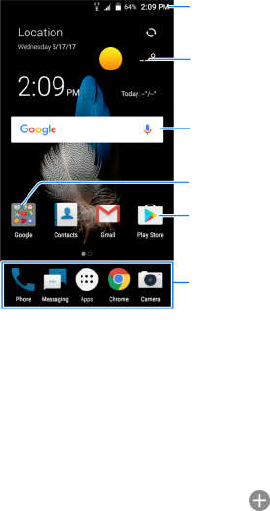
23
Extended Home Screen Panels
Your home screen is extendable, providing more space for
shortcuts, widgets, and more. Simply swipe left or right on the
home screen to see the extended panels. You can add or remove
home screen panels, or adjust their order.
To add a new home screen panel:
1. Touch and hold a blank area of the home screen.
2. Touch Widgets or Themes.
3. Slide the home screen thumbnails left and touch .
Status bar
Google Search
Shortcut
Folder
Primary shortcuts
Widget

24
To delete a home screen panel:
1. Touch and hold an empty area of the home screen and touch
Home. You can slide left or right to view the home screen
thumbnails.
2. Touch on the top right corner of a thumbnail.
3. Touch OK. The items on the panel will also be removed.
NOTE:
When there are only two home screen panels, you cannot delete
any of them.
To adjust the order of a home screen panel:
1. Touch and hold an empty area of the home screen and touch
Home. You can slide left or right to view the home screen
thumbnails.
2. Touch and hold a thumbnail and drag it left or right to the
place you need.
NOTE:
Touch at the bottom of a home screen thumbnail to set it as
the main home screen.

25
Personalizing
Changing the System Language
1. Touch the Home key > > Settings > Language &
input > Languages. The first language in the list is the
default system language.
2. Touch Add a language to add another language to the list.
3. To change the system language, touch and hold next to
the language you want and drag it to the top of the list.
NOTE:
To remove languages from the list, touch > Remove and
select the languages you want to delete.
Setting the Date and Time
1. Touch the Home key > > Settings > Date & time.
2. Set the date, time, time zone, and time format.
To adjust the date and time automatically, turn on
Automatic date & time.
To adjust the date and time manually, turn off Automatic
date & time and touch Set date / Set time to change the
date and time.
To adjust the time zone automatically, turn on Automatic
time zone.

26
To adjust the time zone manually, turn off Automatic
time zone and touch Select time zone to set the correct
time zone.
To adjust the time format, touch Use 24-hour format.
Changing Ringtone and Notification
Sound
You can customize the default incoming call ringtone and the
default notification sound.
1. Touch the Home key > > Settings > Sound.
2. Touch Phone ringtone or Default notification ringtone.
3. Select the ringtone you want to use.
4. Touch OK.
Turning On/Off System Sounds
1. Touch the Home key > > Settings > Sound > Other
sounds.
2. Touch the switch beside each option to turn it on or off.
Adjusting Volume
1. Touch the Home key > > Settings > Sound.
2. Drag the sliders below Media volume, Alarm volume, Ring
volume and Notification volume to adjust the volume for
each type of audio.

27
NOTE:
You can adjust the media volume when a media application is in
use by pressing the Volume key. If no media application is active,
press the Volume key to adjust ringtone volume (or the earpiece
volume during a call) or touch to adjust other types of
volume.
Switching to Silent or Vibration Mode
You can set the phone to silent or vibration mode by using one of
the following methods.
Press the Volume key when no media application is active to
show the volume management window. Drag the slider to the
left or keep pressing the Volume down key to switch the
phone to vibration mode. Press the key again in vibration
mode to switch the phone to silent mode.
Swipe down from the top of the screen to open the notification
panel and drag the panel downwards. Slide left and then
touch Sound or Vibrate to switch the phone to vibration or
silent mode.
Touch the Home key > > Settings > Sound >
Notification mode and select Vibrate or Mute to switch to
vibration or silent mode.
NOTE:
To restore normal sound settings, press or hold the Volume up
key.

28
Using Do Not Disturb Mode
You can limit interruptions with Do not disturb mode. This mode
silences your phone so that it doesn’t make sounds or vibrate
when you don’t want it to.
To turn on Do not disturb mode:
1. Touch the Home key > > Settings > Sound > Do not
disturb.
2. Touch Do not disturb and select Always or Scheduled.
3. Set the detailed settings.
If you have selected Scheduled, set the days and
start/end time during which Do not disturb mode should
apply.
Touch Disturb rules to determine whether you allow
exceptions.
- Priority only: Disturbance set as priority interruptions
are allowed.
- Alarms only: Only alarms sound or vibration is
allowed.
- Total silence: Forbid all disturbance.
If you have allowed priority interruptions, customize the
types of allowed sounds or vibration in the Priority
interruptions section.
NOTE:
To turn off Do not disturb mode quickly, press either end of the
Volume key and then touch END NOW.

29
To set exceptions for Do not disturb mode:
You can set reminders, certain calls and messages as exceptions
when Do not disturb mode is on and Priority only is selected as
the disturb rule, so these ringtones, sounds and vibration are not
turned off.
1. Touch the Home key > > Settings > Sound > Do not
disturb.
2. Touch the switches next to the items you want to allow. Touch
Messages or Calls and set who can alert you of their
messages or calls.
NOTE:
To set exceptions based on apps, touch the Home key > >
Settings > Notifications. Select an app and switch on Override
Do Not Disturb.
Applying New Wallpapers
You can set the wallpaper for the home screen or lock screen.
1. Touch the Home key > > Settings > Display >
Wallpaper.
2. Touch Gallery, Live Wallpapers, Photos, or Wallpapers
and select an image or an animation. Some cropping may be
needed for Gallery and Photos images.
3. If necessary, touch Set wallpaper.
4. If prompted, select to set the image as the lock screen
wallpaper, the home screen wallpaper or both.
NOTE:

30
In addition, you can touch and hold an empty place on the home
screen, touch Wallpapers and then touch Lock screen or Home
screen. Then select a built-in image, a live wallpaper, or an
image from your Gallery.
Setting the Theme
1. Touch and hold an empty place on the home screen and
touch Themes.
2. Select a theme you like.
Setting the Home Screen Transition
Effect
1. Touch and hold an empty place on the home screen and
touch Home.
2. Pick an effect and the phone will demonstrate how it works.
Touch other effects until you find the favourite one.
Changing Screen Brightness
1. Touch the Home key > > Settings > Display >
Brightness level.
2. Drag the slider to manually adjust the screen brightness.
NOTE:
Your phone can automatically adjust the screen brightness for
available light. Touch Adaptive brightness in the Display
settings screen to turn the feature on or off.

31
Protecting Your Phone With Screen
Locks
You can protect your phone by creating a screen lock. When it is
enabled, you need to touch and hold on the screen, draw a
pattern or enter a numeric PIN or password to unlock the phone’s
screen and keys.
1. Touch the Home key > > Settings > Security > Screen
lock.
2. Touch None, Long press, Pattern, PIN or Password.
Touch None to disable the screen lock.
Touch Long press to enable screen lock and allow
unlocking with a ‘touch and hold' gesture. You can unlock
the screen by touching and holding on the blank area of
the screen.
Touch Pattern to draw and redraw a pattern that you
must draw to unlock the screen.
Touch PIN or Password to set a numeric PIN or a
password that you must enter to unlock the screen.
3. For Pattern, PIN, or Password lock, select how you want
notifications and their contents to show when the phone is
locked. Then touch DONE.
NOTE:
Remember the pattern, PIN or password you set. Otherwise, you
will have to upgrade the phone software to use the phone. See
Upgrading the Phone Software.

32
Protecting Your Phone With Encryption
You can encrypt all the data on your phone: your accounts,
application data, music and other media, downloaded information,
and so on. If you do, you must draw an unlock pattern, enter a
numeric PIN or a password each time you power on your phone.
WARNING!
Encryption is irreversible. The only way to revert to an
unencrypted phone is to perform a factory data reset, which
erases all your data.
Encryption provides additional protection in case your phone is
stolen, and may be required or recommended in some
organizations. Consult your system administrator before turning it
on. In many cases the pattern, PIN or password you set for
encryption is controlled by the system administrator.
Before turning on encryption, prepare as follows:
●
Set a screen lock pattern, PIN or password.
●
Charge the battery.
●
Keep the phone connected to the charger.
●
Schedule an hour or more for the encryption process: you
must not interrupt it or you will lose some or all of your data.
When you're ready to turn on encryption:
1. Touch the Home key > > Settings > Security > Encrypt
phone.
2. Read the information about encryption carefully.
The ENCRYPT PHONE button is dimmed if your battery is

33
not charged or your phone's not plugged in.
If you change your mind about encrypting your phone, touch
the Back
key.
WARNING!
If you interrupt the encryption process, you will lose data.
3. Touch ENCRYPT PHONE.
4. Draw your screen lock pattern or enter your PIN or password.
5. Touch ENCRYPT PHONE again.
The encryption process starts. Encryption can take an hour or
more, during which time your phone may restart several times.
When encryption is completed, you're prompted to draw the
unlock pattern, or enter your PIN or password.
Subsequently you must draw your unlock pattern, or enter your
PIN or password each time you power on your phone in order to
decrypt it.
Protecting Your Phone With Screen
Pinning
You can use the screen pinning feature to keep an app in view,
so others cannot switch to other apps or access your personal
information.
Turn On Screen Pinning
1. Touch the Home key > > Settings > Security > Screen
pinning.

34
2. Touch the On/Off switch.
3. If you want to ask for the unlock pattern, PIN or password
before unpinning the screen, switch on Ask for unlock
pattern / PIN / password before unpinning when the
screen lock has been set.
Pin a Screen
1. Ensure that screen pinning is turned on.
2. Open the app you want to keep in view.
3. Touch the Recent apps key.
4. If there are many app tabs, swipe up to find on the
front-most tab.
5. Touch .
Unpin the Screen
To unpin the screen and return to normal use, touch and hold the
Back key.
If you have asked for the unlock pattern, PIN or password before
unpinning the screen, touch and hold on the lock screen and
draw the pattern or enter the PIN/password.
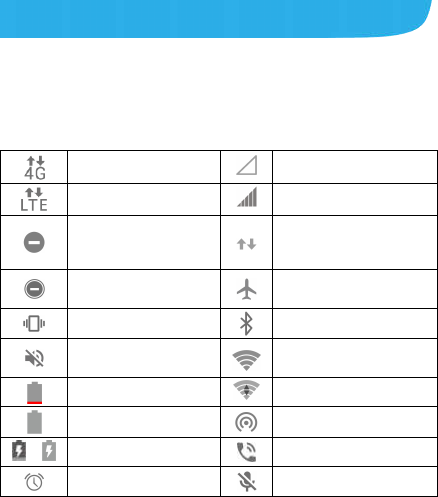
35
Knowing the Basics
Monitoring the Phone Status
The status bar at the top of the home screen provides phone and
service status icons on the right side. Below are some of the
icons you may see.
4G/3G connected No signal
LTE connected Signal strength
Do not disturb mode on
(Alarms only or Priority
only)
Mobile data in use
Do not disturb mode on
(Total silence) Airplane mode
Vibration
mode
Bluetooth on
Silent mode
Connected to a Wi-Fi
®
network
Battery low
Wi-Fi in use
Battery full
Mobile hotspot on
/
Battery charging
Speaker on
Alarm set
Phone microphone off
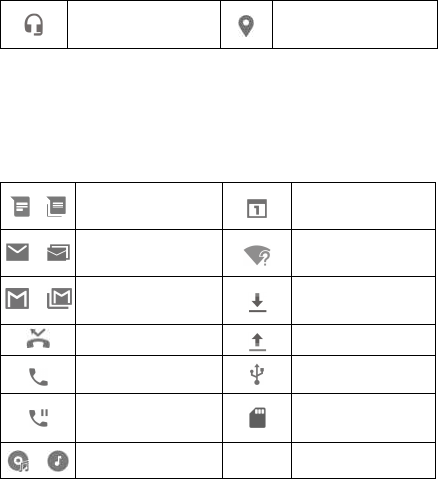
36
Wired headset
connected GPS on
Managing Notifications
Notification Icons
The status bar at the top of the home screen provides notification
icons on the left. Below are some of the icons you may see.
/
New SMS or MMS
messages Upcoming event
/
New message(s) from
the Email app
New Wi-Fi network
detected
/
New message(s) from
the Gmail™ app Downloading data
Missed call
Sending data
Call in progress
USB connected
Call on hold microSDXC card
mounted
/
Song playing

37
Open/Close the Notification Panel
Notifications report the arrival of new messages, calendar
events, and alarms, as well as ongoing events, such as when
you are playing music. You can open the notification panel to
view the details of notifications.
To open the notification panel, swipe your finger down on the
home screen or from the top of the screen.
To close the notification panel, swipe your finger up on the
screen or touch the Back key.
Respond to or Remove a Notification
In the notification panel, you can respond to a notification or
remove the notifications. The notification panel also supports
expandable notifications that let you perform additional actions
right from the notification itself.
To respond to a notification, just touch it.
Slide down with one finger to expand certain notifications.
You can also swipe two fingers vertically or pinch-zoom to
expand or collapse certain notifications, or touch / to
expand or collapse certain notifications and bundled
notifications.
To remove a notification, swipe it left or right.
To remove all non-persistent notifications, touch CLEAR ALL
below all the notifications.
To manage notifications you have received, touch and hold a
notification, or slide it left or right a small amount and touch

38
, and then choose to silence or block the application, or
touch MORE SETTINGS to customize more notification
settings. See Notifications.
NOTE:
If you block notifications for an app, you may miss its important
alerts and updates. The notifications of some apps cannot be
blocked.
Use Quick Settings
The Quick Settings make it convenient to view or change the
most common settings for your phone.
Open the notification panel and you can find a few Quick Settings
on the top. To open the Quick Settings panel and find all setting
tiles, drag the notification panel downwards, or swipe down from
the top of the screen with two fingers.
NOTE:
You can swipe left or right on the Quick Settings panel to find all
setting tiles.
To turn on or off settings quickly:
1. Swipe down from the top of the screen with two fingers to
open the Quick Settings panel.
2. To turn on or off a setting, touch its tile. Touch and hold
certain tiles to access more setting options. For example,
touch and hold the Wi-Fi tile to open Wi-Fi settings.
To customise the Quick Settings panel:
You can add, remove or rearrange the tiles on the Quick Settings

39
panel.
1. Open the Quick Settings panel.
2. Touch at the top and do one of the following.
Touch and hold a tile and drag it to the position you want.
Touch and hold a tile and drag it to the section below to
hide it.
In the Drag to add tiles section, drag a tile up to show it
in the Quick Settings panel.
NOTE:
On the Quick Settings panel, touch at the top to get to the
Settings menu.
Managing Shortcuts and Widgets
Add Shortcuts and Widgets
1. Touch the Home key > .
- or -
To add widgets, touch and hold an empty area of the home
screen and select Widgets.
2. Slide to browse the available applications or widgets.
3. Touch and hold a widget or an application icon and drag it to
a home screen panel.
NOTE:
While holding the item, you can drag it to the right edge of the
screen to create a new home screen panel and put the item on it.

40
Move Shortcuts or Widgets
1. Touch and hold a shortcut or widget on the home screen.
2. Drag it to the place you need.
Remove Shortcuts or Widgets
1. Touch and hold a shortcut or widget on the home screen.
2. Drag it to (Remove) to remove it.
Adjust Widget Size
1. Touch and hold a widget on the home screen and then
release it.
2. An outline appears around the widget. Drag the outline to
resize the widget.
NOTE:
Not all widgets can be resized.
Organizing With Folders
You can create folders on the home screen and add several
shortcuts to a folder.
You can move or remove folders the same way as moving or
removing shortcuts.
1. Touch and hold a shortcut on the home screen until
(Folder) appears.
2. Drag the shortcut to (Folder) and release it. A new folder
will be created and the shortcut is added into the folder.
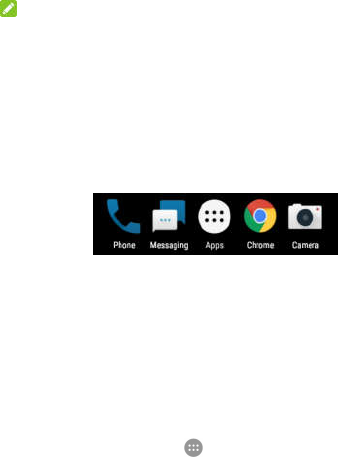
41
3. To add more shortcuts into the folder, touch and hold each
shortcut and drag it over the folder before releasing it.
NOTE:
Touch the folder and then touch the name field to rename the
folder.
Rearranging the Primary Shortcuts
The home screen includes a customizable primary shortcuts area
at the bottom visible from all home screens. You can keep at
most four items in the primary shortcuts area. Drag shortcuts or
folders in or out of the area to rearrange it.
Entering Text
You can enter text using the onscreen keyboard. Some apps
open it automatically. In others, you open it by touching where
you want to type. Touch the Back key to hide the onscreen
keyboard. You can also enter text by speaking with the Google
voice typing feature.
Enable or Disable Input Methods
1. Touch the Home key > > Settings > Languages &
input > Virtual keyboard.

42
2. Touch Manage keyboards.
3. Slide the switches beside the input methods to enable or
disable them.
Change Input Methods
1. When you use the onscreen keyboard to enter text, open the
notification panel and touch (Change keyboard).
2. Select the input method you need.
NOTE:
The icon appears only when more than one keyboard input
method is installed and enabled.
Google Keyboard
The Google Keyboard provides a layout similar to a desktop
computer keyboard. When screen auto-rotation is enabled, turn
the phone sideways and the keyboard will change from portrait to
landscape. The landscape keyboard is not supported in all
applications.

43
Touch the alphabetic keys to enter letters. Touch and hold
some specific keys to enter associated accented letters or
numbers. For example, to enter É, touch and hold and
the available accented letters and number 3 appear. Then
slide to choose É.
As you enter a word, candidates appear above the keyboard.
Touch to select the correct one; drag a suggestion to to
remove it.
Touch to use uppercase. Double-tap to lock
uppercase. This key also changes to indicate the current
case you are using: for lowercase, for uppercase,
and when locked in uppercase.
Touch to delete the text before the cursor.
Touch to select numbers and symbols. You can then

44
touch to find more or touch to enter miniature
icons.
Touch to enter miniature icons, such as expressions,
horoscopes, and animals.
Touch to use Google voice typing.
Touch and hold to change the input language or set up
the Google Keyboard.
Touch and hold and then slide right to resize the
keyboard for one-hand input.
Gesture Typing
The Google Keyboard supports the gesture typing feature. You
use this feature to input a word by sliding through the letters.
To enable and use gesture typing:
1. Touch and hold on the Google Keyboard and then touch
Google Keyboard settings.
2. Touch Gesture typing and then touch Enable gesture
typing if this feature is turned off.
3. Move your finger from letter to letter on the keyboard to trace
a word without lifting the finger until you reach the end of the
word.
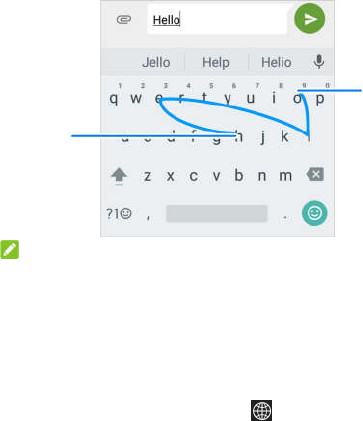
45
NOTES:
Touch when you want to. If you want to enter a single letter,
go ahead and touch.
Lift your finger at the end of the word. A space is added
automatically when you begin to input the next word.
TouchPal Keyboard
The TouchPal keyboard offers three layouts including FULL,
PHONEPAD, and T+. You can touch to select a language
and layout.
You can also use Curve
®
and Wave™ to speed up text input by
moving your finger from letter to letter or word from word without
lifting the finger.
Start of
the word
End of
the word
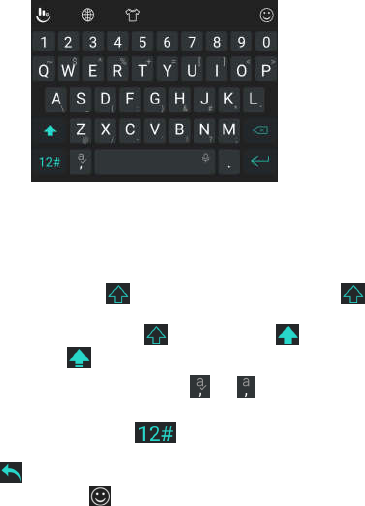
46
The Full Layout
The FULL layout offers an input experience similar to a computer
keyboard.
The alphabetic keys: Touch the keys to enter letters. Touch
and hold a key and slide if necessary to choose more
characters.
The shift key: Touch to use uppercase. Double-tap
to lock uppercase. This key also changes to indicate the
current case you are using: for lowercase, for
uppercase, and when locked in uppercase.
Word prediction: Touch and hold or and touch the
prediction switch to turn off or on prediction.
Pre-defined texts: Touch to enter digits, symbols, and
other texts. You can touch the arrow keys to turn pages, or
touch to go back to the alphabetic keys. Slide up on the
space key or touch to enter Emoji and emoticons.
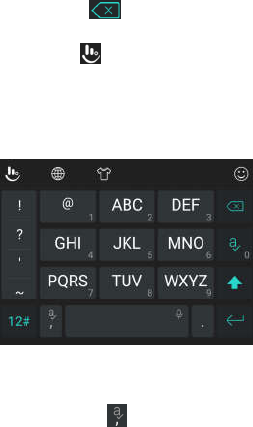
47
The delete key: Touch to delete text before the cursor.
You can also slide left on the key to delete a whole word.
More options: Touch to access additional functions of
TouchPal, use voice input, edit text, change keyboard themes,
and more.
The PHONEPAD Layout
This layout is similar to a phonepad.
Touch an alphabetic key repeatedly until the desired letter
appears. You can also touch and hold the key and slide left or
right to choose the letter or number you need.
If word prediction is enabled ( ), just touch the keys once and
choose the right word.
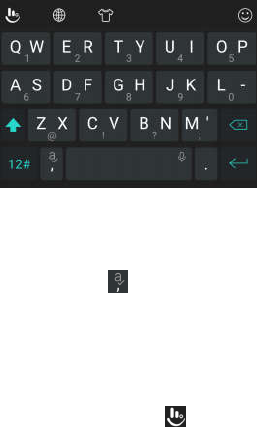
48
The T+ Layout
Touch to enter the left letter on the key. Double-tap or flick right to
enter the right letter/symbol on the key. You can also touch and
hold a key and slide left or right to choose more letters and
symbols.
If word prediction is enabled ( ), just touch the keys once and
choose the right word.
Curve - Word Gesture
Curve allows you to enter text by moving your finger on the
screen from letter to letter to enter each word.
To enable and use Curve:
1. On the TouchPal keyboard, touch > Settings > Smart
input and check Curve
®
- Word gesture.
2. Touch the Back key to return to the text field. Open the
TouchPal keyboard and switch to the FULL layout.
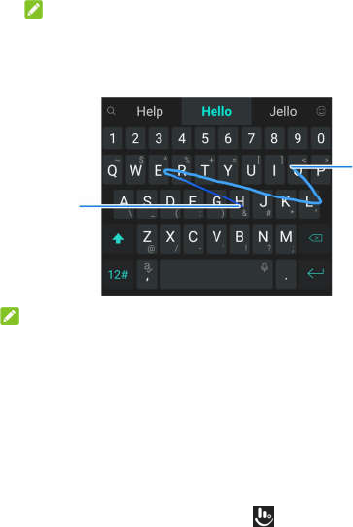
49
NOTE:
Curve is only available in the FULL layout.
3. Move your finger from letter to letter on the keyboard to trace
a word without lifting until you reach the end of the word.
NOTES:
Touch when you want to. If you want to enter a single letter, go
ahead and touch the key.
Lift your finger at the end of the word. A space is added
automatically when you begin to trace the next word.
Wave - Sentence Gesture
Wave allows you to enter words by dragging candidate words to
the space key.
To enable and use Wave:
1. On the TouchPal keyboard, touch > Settings > Smart
Start of
the word
End of
the word
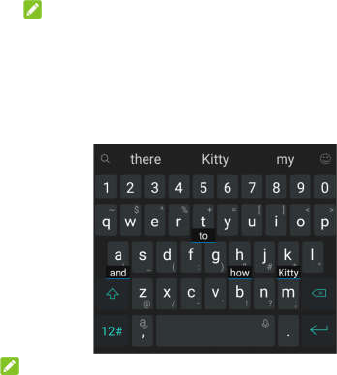
50
input and check Wave™ - Sentence gesture.
2. Touch the Back key to return to the text field. Open the
TouchPal keyboard and switch to the FULL layout.
NOTE:
Wave is only available in the FULL layout.
3. Touch or use Curve to enter the first word. As the first word
appears on the text field, candidate words appear on the
keyboard for you to choose from as the following word.
4. Drag the correct candidate word to the space key to add the
word to the text field.
NOTE:
If no candidate word is correct or displayed, you can go on
entering the words normally.

51
Google Voice Typing
Google voice typing uses the Google voice recognition service to
convert speech to text.
1. Touch to access the voice typing feature when you are
using the Google Keyboard.
Or flick down the status bar when entering text and touch
Change keyboard, and then select Google voice typing.
2. When you see the microphone image, speak what you want
to type.
3. You can continue entering text to keep it or to delete it.
NOTE:
Say "comma," "period," "question mark," "exclamation mark," or
"exclamation point" to enter punctuation.
Input Method Settings
Choose the input method settings by touching > Settings >
Languages & input > Virtual keyboard from the home screen.
You can set the current input method and choose the settings for
input methods.
Editing Text
Move the insertion point: Touch where you want to type.
The cursor blinks in the new position, and a tab appears
below it. Drag the tab to move the cursor.

52
Select text: Touch and hold or double-tap within the text.
The nearest word highlights, with a tab at each end of the
selection. Drag the tabs to change the selection.
Cut or copy: Select the text you want to manipulate. Then
touch CUT or COPY to cut or copy the text to the clipboard.
Replace text with the clipboard text: Select the text you
want to replace. Then touch PASTE.
Insert clipboard text to the text field: Touch the tab below
the cursor and then select PASTE.
Opening and Switching Apps
Open an App
1. Touch the Home key > .
2. Slide up or down on the screen and touch an app to open it.
NOTE:
Drag the slider on the right side of the screen to the initial letter of
the app you need, or touch the search box at the top to search for
apps.
Switch Between Recently Opened Apps
1. Touch the Recent apps key. The apps you’ve used recently
are displayed in a series of tabs. Slide up and down to see all
the tabs.
2. Touch a tab to open that app.

53
NOTE:
You can swipe a tab sideways or touch X on the tab to remove it
from the screen. Touch Clear all to remove all tabs.
NOTE:
Double-tap the Recent apps key to quickly switch between two
most recently opened apps.
Using Two Apps in Split-Screen Mode
You can work with two apps at the same time in split-screen
mode.
NOTE:
Some apps may not support split-screen mode.
1. Open the first app you want to use and then touch and hold
the Recent apps key. The screen is divided into two.
-or-
Touch the Recent apps key to view your recently used apps,
touch and hold the tab of the app you want to use and drag it
to the Drag here to use split screen area.
2. You can do one of the following.
If the app you need is in the recent apps list, touch it to set
it as the second app.
Touch the Home key to find the app you need and open it
as the second app.
To turn off split-screen mode, touch and hold the Recent apps
key, or drag the handle on the screen to the edge of the

54
screen.
Uninstalling or Disabling an App
1. Touch the Home key > to open the application list
screen.
2. Touch and hold an application icon and drag the icon to
(Uninstall) or (Disable) at the top of the screen.
3. Touch OK to uninstall or disable the app.
NOTES:
Not all apps cannot be uninstalled or disabled.
To find the disabled applications, touch the Home key > >
Settings > Apps and touch > Disabled. You can then
touch an application and touch ENABLE to restore it.

55
Connecting to Networks and
Devices
Connecting to Mobile Networks
Control Mobile Data Use
To enable or disable data access:
1. Touch the Home key > > Settings > Mobile networks >
Mobile Data.
2. Touch the Mobile Data switch to enable or disable mobile
data use.
To get data services when roaming:
1. Touch the Home key > > Settings > Mobile networks >
International Data Roaming.
2. Touch the Mobile Data switch if it is turned off.
NOTE:
Data roaming may incur significant roaming charges.
Select Preferred Network Type
1. Touch the Home key > > Settings > Mobile networks >
Preferred network type.
2. Touch the type of network you prefer to connect to.

56
Set Access Point Names
To connect to the Internet you can use the default Access Point
Names (APN). And if you want to add a new APN, please contact
the service provider to get the necessary information.
1. Touch the Home key > > Settings > Mobile networks >
Access Point Names.
2. Touch .
3. Touch each item to enter the information you get from your
service provider.
4. Touch > Save to complete.
NOTE:
To set the APN to default settings, touch > Reset to default.
Select Network Operator
1. Touch the Home key > > Settings > Mobile networks >
Network operators.
2. Touch Search networks to search for all available networks
and select one to register manually. You can also touch
Choose automatically to select preferred network
automatically.
Disable 2G Service
1. Touch the Home key > > Settings > Mobile networks.
2. Touch the Disable 2G switch to turn it on.

57
CAUTION:
If 2G service is disabled, some apps and functions may not work
in areas with limited coverage.
Connecting to Wi-Fi
Wi-Fi is a wireless networking technology that can provide
Internet access at distances of up to 300 feet, depending on the
Wi-Fi router and your surroundings.
Turn Wi-Fi On and Connect to a Wi-Fi
Network
1. Touch the Home key > > Settings > Wi-Fi.
2. Slide the Wi-Fi switch to the On position to turn on Wi-Fi.
3. Touch a network name to connect to it.
4. If the network is secured, enter the password and touch
CONNECT.
NOTE:
Your phone automatically connects to previously used Wi-Fi
networks when they are in range.
Get Notified of Open Networks
1. Touch the Home key > > Settings > Wi-Fi.
2. Slide the Wi-Fi switch to the On position.
3. Touch .
4. Slide the Network notification switch.

58
When Wi-Fi is on, you receive notifications in the status bar when
your phone detects an open Wi-Fi network. Switch off this option
to turn off notifications.
Add a Wi-Fi Network
You can add a Wi-Fi network if the network does not broadcast
its name (SSID), or to add a Wi-Fi network when you are out of
range.
To connect to a secured network, you first need to get the
security details from the network's administrator.
1. Touch the Home key > > Settings > Wi-Fi.
2. Slide the Wi-Fi switch to the On position.
3. At the bottom of the available Wi-Fi networks, touch Add
network.
4. Enter the network SSID (name). If necessary, enter security
or other network configuration details.
5. Touch SAVE.
Connect to a WPS Network
Wi-Fi Protected Setup (WPS) is a feature that makes it easy to
add your phone to the access points which support WPS.
You can use one of the following methods to connect your phone
to a wireless network using WPS.
Method one: WPS button (Recommended)
1. Touch the Home key > > Settings > Wi-Fi.

59
2. Slide the Wi-Fi switch to the On position.
3. Touch > Advanced > WPS Push Button.
4. Press the WPS button on the access point and the access
point will recognize your phone and add it to the network.
Method two: PIN number
1. Touch the Home key > > Settings > Wi-Fi.
2. Slide the Wi-Fi switch to the On position.
3. Touch > Advanced > WPS Pin Entry.
4. The WPS PIN number displays on the screen. Enter the PIN
number into the access point's setup page.
After entering the PIN number, your phone automatically finds
the access point and configures the connection.
NOTE:
For detailed information about the WPS feature of the access
point, please refer to its user documents.
Forget a Wi-Fi Network
You can make your phone forget about the details of a Wi-Fi
network that you added - for example, if you don’t want the phone
to connect to it automatically or if it is a network that you no
longer use.
1. Touch the Home key > > Settings > Wi-Fi.
2. Slide the Wi-Fi switch to the On position.
3. Touch and touch Saved networks.

60
4. Touch the Wi-Fi network name and then touch FORGET.
Adjust Advanced Wi-Fi Settings
1. Touch the Home key > > Settings > Wi-Fi.
2. Touch to adjust the following settings.
Network notification: Get notifications in the status bar
when Wi-Fi is on and an open network is available.
Keep Wi-Fi on during sleep: Set whether to keep Wi-Fi
on in sleep mode.
MAC address: Check the MAC address.
IP address: Check the phone’s IP address.
- or -
Touch > Advanced to adjust the following settings.
Install certificates: Install certificates needed for
connecting to certain Wi-Fi networks.
Wi-Fi Direct: Use the Wi-Fi Direct feature. See Using
Wi-Fi Direct
®
.
WPS Push Button: Connect to a WPS network via the
push button method.
WPS Pin Entry: Connect to a WPS network via the
phone PIN method.
Using Wi-Fi Direct
®
Wi-Fi Direct allows Wi-Fi devices to share files and data directly

61
by connecting to each other without the need for wireless access
points (hotspots). Your phone supports Wi-Fi Direct, but you may
need to install third-party applications to share data through Wi-Fi
Direct.
To connect via Wi-Fi Direct:
1. Touch the Home key > > Settings > Wi-Fi.
2. If Wi-Fi is off, slide the Wi-Fi switch to the On position.
3. Touch > Advanced > Wi-Fi Direct. Your phone will search
for other devices enabled with Wi-Fi Direct connections.
4. Touch a device name below Peer devices to connect with it.
The other device will receive a connection prompt and need
to accept the request for connection. Both devices may need
to enter a common PIN.
5. Once connected the device is displayed as “Connected” in
the Peer devices list.
Connecting to Bluetooth Devices
Bluetooth is a short-range wireless communication technology.
Phones or other devices with Bluetooth capabilities can
exchange information wirelessly within a distance of about 30
feet. The Bluetooth devices must be paired before the
communication is performed.
Turn Bluetooth On/Off
1. Touch the Home key > > Settings > Bluetooth.
2. Slide the Bluetooth switch to the On or Off position.

62
When Bluetooth is on, the icon appears in the status bar.
Change the Device Name
1. Touch the Home key > > Settings > Bluetooth.
2. Slide the Bluetooth switch to the On position if Bluetooth is
off.
3. Touch > Rename this device.
4. Edit the name and touch RENAME.
Pair With Another Bluetooth Device
1. Touch the Home key > > Settings > Bluetooth.
2. Slide the Bluetooth switch to the On position if Bluetooth is
off.
Your phone automatically scans for and displays the IDs of
all available Bluetooth devices in range. You could touch
> Refresh if you want to scan again.
3. Touch the device you want to pair with.
4. Confirm that the Bluetooth passkeys are the same between
the two devices and touch PAIR. Alternately, enter a
Bluetooth passkey and touch PAIR.
Pairing is successfully completed when the other device
accepts the connection or the same passkey is entered.
NOTE:
The Bluetooth passkey may be fixed for certain devices, such as
headsets and hands-free car kits. You can try entering 0000 or

63
1234 (the most common passkeys), or refer to the documents for
that device.
Forget (Unpair With) a Bluetooth Device
You can make your phone forget its pairing connection with
another Bluetooth device. To connect to the device again, you
need to search it and enter or confirm a passkey again.
1. Touch the Home key > > Settings > Bluetooth and
ensure that Bluetooth is turned on.
2. In the list of paired devices, touch the icon beside the
Bluetooth device you want to forget.
3. Touch FORGET.
Send Data via Bluetooth
1. Open the appropriate application and select the file or item
you want to share.
2. Select the option for sharing via Bluetooth. The method may
vary by application and data type.
3. Touch a Bluetooth device the phone has paired with or wait
for it to search for new devices and touch one of them.
Receive Data via Bluetooth
1. Turn Bluetooth on before trying to receive data via Bluetooth.
2. Touch ACCEPT to start receiving the data. If necessary, flick
down the status bar, and touch ACCEPT on the Bluetooth
sharing notification.
Depending on your storage setting and whether a microSDXC

64
card is installed, received files are stored automatically in a
dedicated folder (Bluetooth, for instance). You can access them
with the File Manager app.
Connecting to Your Computer via USB
You can connect your phone to a computer with a USB cable and
transfer music, pictures, and other files in both directions. Your
phone stores these files in the phone storage or on a removable
microSDXC card.
Connect Your Phone to a Computer via USB
1. Connect your phone to the PC with a USB cable.
2. Open the notification panel and touch (USB for ...).
3. Choose one of the following options:
Charge only: Charge your phone via USB.
Install driver: Install the driver needed for some USB
connection modes (such as MTP). You only need to install
the driver on the same PC once.
NOTE:
You can also install the driver on PC by running the
executable file in the new CD-ROM drive.
Media device (MTP): Transfer files on Windows
®
or
Mac
®
.
NOTE:
For Windows XP, please install the drivers and Media

65
Player 11 (or later version) when you use Media device
(MTP) for the first time.
Camera (PTP): Transfer photos using camera software.
NOTE:
To make your phone connect to the computer automatically using
the selected connection type, check Don’t ask me again.
Disconnect Your Phone From the Computer
To disconnect the phone from the computer, simply unplug the
USB cable when you’re finished.
Using the microSDXC Card as Portable
or Phone Storage
You can use your microSDXC card as portable storage when
there's already content such as your media and other files so that
you don't lose them.
If your microSDXC card is new or doesn't have content you want
to keep, you can also set it up as an extension of the phone
storage, and this requires formatting that prevents the
microSDXC card from working with other devices.
CAUTION:
As part of the phone storage, the microSDXC card may have
data on it that is necessary for some apps to function normally.
Therefore, do not remove or replace the card randomly.

66
Set Up the microSDXC Card as Portable
Storage
When you install a microSDXC card that has not been used on
your phone before, the phone will mount the card as portable
storage by default.
You can also open the notification panel and touch the
microSDXC card name, select Use as portable storage and
then touch NEXT > DONE.
To remove the microSDXC card from your phone:
If you need to remove the microSDXC card used as portable
storage while the phone is on, you must unmount it first.
1. Touch the Home key > > Settings > Storage.
2. Touch next to the card name in the Portable storage
section.
3. When the screen prompts the card is safely ejected, you can
now remove it from the phone.
To erase and format the microSDXC card:
1. Touch the Home key > > Settings > Storage.
2. Touch the card name in the Portable storage section.
3. Touch Format.
4. Touch ERASE & FORMAT.
CAUTION:
The formatting procedure erases all the data on the microSDXC
card, after which the files CANNOT be retrieved.

67
Set Up the microSDXC Card as Phone
Storage
If your microSDXC card is new or doesn't have content you want
to keep, you can format the card and use it as part of the phone
storage. If you move the microSDXC card to another device, it’ll
be formatted before it can be used.
1. Touch the Home key > > Settings > Storage.
2. Touch the card name in the Portable storage section.
3. Touch Format as internal.
4. Touch ERASE & FORMAT.
CAUTION:
The formatting procedure erases all the data on the
microSDXC card, after which the files CANNOT be retrieved.
5. The phone will prompt you to move your photos, files and
other data from the internal storage to the microSDXC card.
Select Move now or Move later and touch NEXT. Follow the
onscreen instructions to continue.
To move data between the internal storage and the
microSDXC card:
With the microSDXC card as part of the phone storage, you can
move your photos, files and other data between the internal
storage and the card any time.
1. Touch the Home key > > Settings > Storage.
2. Touch Phone or the microSDXC card name.
3. Touch Migrate data.

68
4. Touch MOVE.
NOTE:
Whenever you move data between the internal storage and the
microSDXC card, the destination is used to save new apps and
personal data (such as photos and videos) and only the
destination is accessible from a computer.
To remove the microSDXC card from your phone:
If you need to remove the microSDXC card used as phone
storage while the phone is on, you must unmount it first.
1. Touch the Home key > > Settings > Storage.
2. Touch your card name below Phone.
3. Touch Remove SD card.
NOTE:
Before ejecting the card, ensure that you have moved data
and apps to the internal storage.
4. Touch EJECT.
5. When the screen prompts the card is safely ejected, you can
now remove it from the phone.
To reformat the microSDXC card as portable storage:
If you no longer want to use your microSDXC card as phone
storage, you can reformat the card as portable storage.
NOTE:
Before the formatting, ensure that you have moved data and
apps to the internal storage.
1. Touch the Home key > > Settings > Storage.

69
2. Touch your card name below Phone.
3. Touch Format as portable.
4. Touch FORMAT.
CAUTION:
The formatting procedure erases all the data on the microSDXC
card, after which the files CANNOT be retrieved.
Sharing Your Mobile Data Connection
You can share your phone’s data capabilities through USB
tethering or by activating the Wi-Fi hotspot feature to create a
mobile hotspot.
Share Your Mobile Data Connection via USB
You can access the Internet on your computer via the USB
tethering feature of your phone. The feature needs data
connection on a mobile network and may result in data charges.
NOTE:
You cannot transfer files between your phone and your computer
when the phone is USB tethered.
1. Connect your phone to your computer with a USB cable.
2. Touch the Home key > > Settings > More.
3. Switch on USB tethering. A new network connection will be
created on your computer.
NOTE:
To stop sharing your data connection, switch off USB tethering

70
or disconnect the USB cable.
Share Your Mobile Data Connection as a
Mobile Hotspot
You can share your phone’s data connection with other devices
by turning your phone into a portable Wi-Fi hotspot. The feature
needs data connection on a mobile network and may result in
data charges.
NOTE:
When the mobile hotspot feature is enabled, you cannot use your
phone’s Wi-Fi capability to access the Internet. You still remain
connected to the Internet via your mobile data network.
1. Touch the Home key > > Settings > Mobile Hotspot.
2. Slide the switch to the On position.
After a moment, the phone starts broadcasting its Wi-Fi
network name (SSID).
3. On another device, locate your phone via Wi-Fi and connect
with it to start using the phone’s mobile data.
NOTE:
To stop sharing your data connection, slide the switch to the Off
position.
Set Your Mobile Hotspot
You can change the name of your phone's Wi-Fi network (SSID),
secure your mobile hotspot, and set other options.
1. Touch the Home key > > Settings.
71
2. Touch Mobile hotspot and set the following options.
Configure:
-
Network name: Enter or edit a network name (SSID)
that other devices see when scanning for Wi-Fi
networks.
-
Channel: To avoid interference with other Wi-Fi
networks, try using a different channel.
-
Security: Choose a security option, Open (not
recommended) or WPA2 PSK (other users can
access your mobile hotspot only if they enter the
correct password). When you select WPA2 PSK,
touch the Password field to edit the security
password.
-
Show password: Display or hide the security
password.
-
Broadcast network name (SSID): Broadcast or hide
your network name. If the broadcast is disabled, other
users need to get your network name to find the
mobile hotspot.
Manage users: Block or unblock users, or set the
maximum number of devices that can connect to the
hotspot simultaneously.
Sleep policy: Set hotspot sleep policy and notification.
Connecting to Virtual Private Networks
Virtual private networks (VPNs) allow you to connect to the
resources inside a secured local network. VPNs are commonly

72
deployed by corporations, schools, and other institutions to let
people access local network resources when not on campus, or
when connected to a wireless network.
Depending on the type of VPN you are using, you may be
required to enter your login credentials or install security
certificates before you can connect to your VPN. You can get this
information from your network administrator.
Add a VPN
1. Touch the Home key > > Settings > More > VPN.
2. Touch at the top right corner and fill in the information
provided by your network administrator.
3. Touch SAVE.
The VPN is added to the list on the VPN screen.
NOTE:
You must set a lock screen pattern, PIN or password before
using VPN.
Connect to a VPN
1. Touch the Home key > > Settings > More > VPN.
2. Touch the VPN that you want to connect to.
3. When prompted, enter any requested credentials, and then
touch CONNECT.
Modify a VPN
1. Touch the Home key > > Settings > More > VPN.

73
2. Touch beside the VPN that you want to modify.
3. Edit the VPN settings and then touch SAVE.
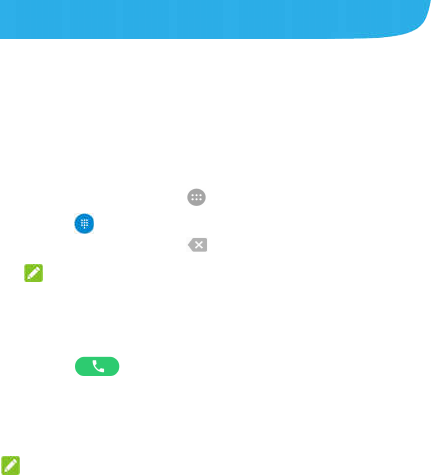
74
Phone Calls
You can place calls from the Phone app, the Contacts app, or
other apps or widgets that display contact information. Wherever
you see a phone number, you can usually touch it to dial.
Placing and Ending Calls
Place a Call by Dialing
1. Touch the Home key > > Phone.
2. Touch and enter the phone number or the contact name
with the dialpad. Touch to delete incorrect digits.
NOTE:
As you enter the phone number or the contact name, your
phone searches for matching information in your contacts. If
you see the number and contact you want to call, touch it to
place the call immediately.
3. Touch below the keypad to dial.
You can also touch the search box at the top of the Phone app
screen and enter the phone number or contact name you want to
call. Touch the matching contact or Call [number] to place the
call.
NOTE:
To make an international call, touch and hold the 0 key to enter
the plus (+) symbol. Next, enter the country code, followed by the
city/area code and then the phone number.

75
NOTE:
To redial the last call you made, just touch when the
phone number field is empty to enter the number automatically.
End a Call
During a call, touch on the screen.
Answering or Rejecting Calls
When you receive a phone call, the incoming call screen opens,
displaying the caller ID or the information about the caller that
you've entered in the Contacts app. You can answer or reject the
call, or reject it with a text message.
Answer a Call
When you receive a phone call, drag to to answer the
call.
- or -
If the screen is unlocked, touch Answer to answer the call.
NOTE:
To silence the ringer before answering the call, you can press the
Volume key, the Power key, the Home key, the Back key, or the
Recent apps key.
Reject a Call
When you receive a phone call, you can:

76
Drag to to reject the call.
- or -
Touch at the bottom to reject the call and select a preset text
message or edit one to send to the caller.
- or -
If the screen is unlocked, touch Dismiss to reject the call, or
touch Message to reject the call and select a preset text
message or edit one to send to the caller.
NOTE:
To edit the preset text response from within the Phone app, touch
in the top search field and select Settings > Quick responses.
Working With the Call History
The call history is a list of all the calls you've placed, received, or
missed. It provides a convenient way to redial a number, return a
call, or add a number to your contacts.
To open the call history, you can touch the Home key > >
Phone > (in the top search field) > Call History.
Place a Call From the Call History
1. Open the call history.
2. Touch beside a listing to call back.
NOTE:
You can touch (missed call), (outgoing call), or
(incoming call) to filter the records by call type.

77
Add a Number From Call History as a Contact
1. Open the call history.
2. Touch the contact icon in front of a number.
3. Touch on the contact information tab.
4. To add the number to an existing contact, touch a contact in
the list. To add a new contact, touch Create new contact.
Take Other Actions on a Call History Entry
Open the call history, touch a listing and then touch Call details
to view more call information.
Touch to delete the entry.
Touch to call the number.
Touch Block number > BLOCK and you will no longer
receive calls or messages from the number.
NOTE:
To find all blocked numbers, touch the Home key > >
Phone > > Settings > Call blocking.
Touch Copy number to copy the number to the clipboard.
Touch Edit number before call to edit the number in the
dialler before calling it.
Touch the contact icon in front of the entry to open the contact
information tab from the bottom. You can send a message,
call back, edit the contact, add the contact to favorites, or add
the number to contacts.
NOTE:

78
Touch > Clear call history in the call history screen to select
and delete the history records.
Calling Your Contacts
1. Touch the Home key > > Phone. Your favorite contacts
and frequently called contacts are displayed in the
FAVORITES tab.
2. Touch a contact to place the call, or touch the CONTACTS
tab and then touch beside a contact to make a call.
Checking Voicemail
If you have set the phone to divert calls to voicemail, callers can
leave voicemail messages when they cannot reach you. Here’s
how to check the messages they left.
1. Touch the Home key > > Phone > .
2. Touch and hold the 1 key in the dialer. If prompted, enter your
voicemail password.
3. Follow the voice prompts to listen to and manage your
voicemail messages.
NOTE:
See Set Voicemail for how to set your voicemail service. For
detailed information, please contact the service provider.

79
Using Options During a Call
During a call, you will see a number of onscreen options. Touch
an option to select it.
Touch to turn on or off the speaker.
Touch to mute or unmute your microphone.
Touch to switch to the keypad when you need to enter a
code (for example, the PIN for your voicemail or bank
account) during the call.
Touch to put the call on hold when this option is
available.
Touch to make another call separately from the first call,
which is put on hold.
Touch to open the Contacts app.
Touch to put the caller you are speaking to on hold, and
switch to the other call that has been put on hold.
Touch to merge the separate calls into a single
conference call.
Touch to end the current call.
WARNING!
Because of higher volume levels, do not place the phone near
your ear during speakerphone use.

80
Managing Multi-party Calls
When the call waiting and three-way call features are available,
you can switch between two calls or set up a conference call.
NOTE:
The call waiting and three-way call features need network
support and may result in additional charges. Please contact your
service provider for more information.
Switch Between Current Calls
When you’re on a call and another call comes in, your phone
screen informs you and displays the caller ID.
To respond to an incoming call while you’re on a call:
Touch Hold current and answer to answer the call. (This
puts the first caller on hold and answers the second call.)
Touch End current and answer to answer the second call
and end the first one.
Touch to reject the second call.
Touch to reject the second call and select a preset
text message or edit one to send to the caller.
To switch between two calls:
Touch to switch back to the other call.
Set Up a Conference Call
With this feature, you can talk to two people at the same time.

81
1. Place the first call.
2. Once you have established the connection, touch and dial
the second number. (This puts the first caller on hold.)
3. When you’re connected to the second party, touch .
If one of the people you called hangs up during your call, you and
the remaining caller stay connected. If you initiated the call and
are the first to hang up, all callers are disconnected.
To end the conference call, touch .
Adjusting Your Call Settings
The call settings menu lets you configure a number of settings for
the phone application.
Set Contact Display Options
You can set the order of the contacts displayed in the
CONTACTS tab of the Phone app.
1. Touch the Home key > > Phone > > Settings >
Display options.
2. Touch Sort by or Name format to set the order of the
contacts and the format of the contact names.
Set Sound and Vibration
Set the sound and vibration for incoming calls as well as dialpad
sounds.
1. Touch the Home key > > Phone > > Settings >

82
Sounds and vibration.
2. Touch the following options you want to configure.
Touch Phone ringtone to select the ringtone for incoming
call notification.
Check Also vibrate for calls to enable vibration for
incoming call notification.
Check Dialpad tones to play sounds when you touch the
dialpad keys.
Set Options for Answering and Ending Calls
When enabled, these options allow you to end a call by pressing
the Power key or allow the phone to vibrate when a call is
answered.
1. Touch the Home key > > Phone > > Settings >
Answer and end calls.
2. Check or uncheck Power button ends call or Vibrate when
call is answered.
Set Speed Dials
You can touch and hold the 1 ~ 9 keys from the dialer to call the
corresponding speed dial number.
The number key 1 is reserved to speed dial your voicemail.
To assign a speed dial key:
1. Touch the Home key > > Phone > > Settings >
Speed dial.
2. Touch a speed dial key.

83
3. Enter a phone number or select one from the contact list.
4. Touch OK.
Edit Quick Response to Rejected Callers
1. Touch the Home key > > Phone > > Settings > Quick
responses.
2. Touch a text message to edit it.
Set Voicemail
1. Touch the Home key > > Phone > > Settings > Call
settings.
2. Touch Voicemail to configure voicemail settings.
Touch Service to select the voicemail service provider.
Your carrier is the default.
Touch Setup > Voicemail number to view or edit the
voicemail number.
Touch Sound to select the notification sound for new
voicemails.
Check Vibrate to enable vibration for notification.
Use Fixed Dialing Numbers
Fixed Dialing Numbers (FDN) allows you to restrict outgoing calls
to a limited set of phone numbers.
1. Touch the Home key > > Phone > > Settings > Call
settings.
2. Touch Fixed Dialing Numbers and the following options are

84
available.
Enable FDN: Input the PIN2 code to enable the FDN
feature.
Change PIN2: Change the PIN2 code for FDN access.
FDN list: Manage the FDN list.
NOTE:
The PIN2 code is provided by your carrier. Entering an incorrect
PIN2 code more times than allowed can get your nano-SIM card
locked. Contact the service provider for assistance.
Forward Incoming Calls
Call forwarding feature allows you to forward your incoming calls
to another phone number.
1. Touch the Home key > > Phone > > Settings > Call
settings > Call forwarding.
2. Touch an available option to enable it.
Set Call Waiting
This option allows you to get notified of incoming calls during a
call.
1. Touch the Home key > > Phone > > Settings > Call
settings > Call waiting.
2. Choose to activate or deactivate it.
Display or Hide Caller ID
1. Touch the Home key > > Phone > > Settings > Call

85
settings > Additional settings.
2. Touch Caller ID to choose whether your number is displayed
when someone receives your outgoing call.
NOTE:
Please contact the service provider to check whether the caller
ID feature is available.
Set Call Blocking
You can add numbers to the blocked numbers list to filter out
calls and messages from these numbers.
1. Touch the Home key > > Phone > > Settings > Call
blocking.
2. Touch ADD A NUMBER.
3. Enter the phone number or select one from the contacts.
4. Touch BLOCK.
NOTE:
To unblock a number, touch on its right and touch
UNBLOCK.
Set TTY Mode
Your phone is a TTY compatible device. A TTY device can allow
people who have hearing or speech disabilities to communicate
by telephone. Simply connect the TTY device to the phone’s
headset jack.
Select a TTY mode for your phone to work with a TTY device, or
turn TTY off.

86
1. Touch the Home key > > Phone > > Settings >
Accessibility > TTY mode.
2. Select one of the following options. Consult your
teletypewriter manufacturer’s manual if necessary.
TTY Off: Users who can hear and talk can disable TTY
support.
TTY Full: Users who cannot talk or hear may use this
mode to send and receive text messages through TTY
device.
TTY HCO: Users who can hear, but cannot talk, may use
this mode to listen to conversation of the other party, and
respond via text messages.
TTY VCO: Users who can talk, but cannot hear, may use
this mode to talk through the phone and receive
responses via text messages.
Set Hearing Aids
Your phone supports the Hearing Aid Compatibility (HAC)
function. When you turn on the hearing aid compatibility and use
a hearing aid with a telecoil to answer the phone, it will help you
hear more clearly during the phone call.
1. Touch the Home key > > Phone > > Settings >
Accessibility.
2. Check Hearing aids to turn on hearing aid compatibility.
CAUTION:
Do not turn on the Hearing aids option unless you use a hearing

87
aid with a telecoil. Using this setting without a hearing aid or with
a hearing aid without a telecoil may be harmful to your hearing.
Enable VoLTE
You can use LTE services to improve call quality.
1. Touch the Home key > > Settings > More.
2. Touch Enhanced LTE Services to turn the feature on or off.

88
Contacts
You can add contacts on your phone and synchronize them with
the contacts in your Google account or other accounts that
support contact syncing.
To see your contacts, touch the Home key >
> Contacts.
From there, you can touch the tabs on the top of the screen to
quickly switch to favorite contacts and contact groups.
Checking Contact Details
1. Touch the Home key >
> Contacts and touch the
CONTACTS tab to access your contact list.
2. Scroll through the list to view all your contacts.
3. Touch a contact to view its details.
NOTE:
If you have a lot of contacts stored, you'll see a slider on the right
side of the screen. Drag the slider to the initial letter you need.
Adding a New Contact
1. Touch the Home key >
> Contacts.
2. Touch to add a new contact.
3. Enter the contact name, phone numbers or email
addresses. If you have added a sync account, touch
Saving to to choose where the contact will be saved.

89
4. If necessary, touch More Fields to add other information
including phone ringtone and notification ringtone.
5. Touch to save the contact.
Setting Up Your Own Profile
You can create your own name card in your phone.
1. Touch the Home key >
> Contacts and touch the
CONTACTS tab.
2. Touch Set up my profile.
If a profile has already been set up, touch the existing
profile below ME and touch .
3. Edit your profile information.
4. Touch .
Importing, Exporting, and Sharing
Contacts
You can import/export contacts from/to the nano-SIM card, the
phone storage or the microSDXC card. This is especially useful
when you need to transfer contacts between different devices.
You can also quickly share contacts using Messaging, Email,
Bluetooth, Google Drive, Gmail, etc.

90
Import Contacts From the Phone Storage or
the microSDXC Card
1. Touch the Home key >
> Contacts.
2. Touch > Import/Export > Import from storage.
3. Select the vCard file(s) in the microSDXC card or the phone
storage and touch OK.
Import Contacts From the nano-SIM Card
1. Touch the Home key >
> Contacts.
2. Touch > Import/Export > Import from SIM card.
3. Check the contacts you need and then touch .
Export Contacts to the Phone Storage or the
microSDXC Card
1. Touch the Home key >
> Contacts.
2. Touch > Import/Export > Export to storage.
3. The phone will prompt you with the name of the vCard file and
the directory in which the file will be saved. Touch OK to
create the file.
Export Contacts to the nano-SIM Card
1. Touch the Home key >
> Contacts.

91
2. Touch > Import/Export > Export to SIM card.
3. Check the contacts you need and then touch .
Share Contacts
1. Touch the Home key >
> Contacts and touch the
CONTACTS tab.
2. Touch > Multi-select.
3. Touch the contacts you want to share and then touch .
4. Choose how to share the contacts. Options depend on the
applications and services installed.
Working With Favorite Contacts
In the favorite contacts tab, you can find your favorite contacts
and frequently contacted contacts.
Add a Contact to Favorites
You can add the contacts you use frequently to FAVORITES so
that you can find them quickly.
1. Touch the Home key >
> Contacts and touch the
CONTACTS tab.
2. Touch a contact and then touch at the top.

92
Remove a Contact From Favorites
1. Touch the Home key >
> Contacts and touch the
FAVORITES tab.
2. Touch a favorite contact and then touch at the top.
Working With Groups
View Your Contact Groups
1. Touch the Home key >
> Contacts and touch the
GROUPS tab.
2. Scroll through the list to view the preset groups and any
groups you have created.
3. Touch a group to view its members.
NOTE:
To send a message or an email to all or some of the group
members, you can touch > Send group message / Send
group email after you open the group.
Set Up a New Group
1. Touch the Home key >
> Contacts and touch the
GROUPS tab.
2. Touch to create a new group.
3. If you have added contact accounts other than the phone,

93
select an account for the new group.
4. Touch the Group’s name field and enter the group name.
5. Touch Add member and select the contacts you wish to be
the group members.
6. If necessary, touch the field below RINGTONE and
NOTIFICATION RINGTONE to select the ringtone for
incoming calls and notifications from the group members.
7. Touch to save the group.
Delete a Group
1. Touch the Home key >
> Contacts and touch the
GROUPS tab.
2. Touch a group and then touch > Delete group.
3. Touch OK to disband the group. The contacts in the group
will not be deleted.
Edit a Group
1. Touch the Home key >
> Contacts and touch the
GROUPS tab.
2. Touch a group and then touch > Edit group.
3. Touch the group name to edit it, or touch the field below
MEMBER, RINGTONE or NOTIFICATION RINGTONE to
add more members or change the ringtone.
4. Touch .

94
NOTE:
To remove group members, touch a group and touch >
Multi-select to choose members. Then touch > OK.
Searching for a Contact
1. Touch the Home key >
> Contacts.
2. Touch at the top of the screen.
3. Input the contact name or any information the contact has to
search for it. The contacts matched will be listed.
Editing Contacts
Edit Contact Details
1. Touch the Home key >
> Contacts.
2. Touch a contact you need to edit and then touch .
3. Edit the contact and touch .
Join Duplicate Contacts
As your phone synchronizes with multiple online accounts, you
may see duplicate entries for the same contact. You can merge
all the separate information of a contact into one entry in the
contacts list.

95
1. Touch the Home key >
> Contacts.
2. Touch and hold a contact to select it.
3. Touch the duplicate contacts to select them.
4. Touch and touch LINK.
Separate Contact Information
If contact information from different sources was joined in error,
you can separate the information back into individual contacts on
your phone.
1. Touch the Home key >
> Contacts.
2. Touch a joint contact you want to separate.
3. Touch and touch > Unlink.
4. Touch UNLINK to confirm.

96
Web Accounts
Adding or Removing Accounts
You can add multiple Google accounts and Microsoft Exchange
ActiveSync
®
accounts. You may also add other kinds of
accounts depending on the apps installed on your phone.
Add an Account
1. Touch the Home key > > Settings > Accounts > Add
account.
2. Touch the type of account you want to add.
3. Follow the onscreen steps to enter the information about the
account. Most accounts require a username and password,
but the details may vary. You may also need to obtain some
information from IT support or your system administrator.
When the account is successfully added, it is displayed in the
Accounts menu.
Remove an Account
Removing an account will delete it and all information
associated with it from your phone, such as emails and
contacts.
1. Touch the Home key > > Settings > Accounts.
2. Touch the account category and then touch the account.

97
3. Touch > Remove account > REMOVE ACCOUNT.
Configuring Account Sync
Configure Auto Sync Setting
1. Touch the Home key > > Settings > Accounts.
2. Touch and check or uncheck Auto-sync data.
When automatic sync is turned on, changes you make
to information on your phone or on the web are
automatically synced with each other.
When automatic sync is turned off, you need to sync
manually to collect emails, updates, or other recent
information.
Sync Manually
1. Touch the Home key > > Settings > Accounts.
2. Touch the account category and then the account you want
to sync.
3. Touch > Sync now. Or touch the types of information you
want to sync.

98
Change an Account’s Sync Settings
1. Touch the Home key > > Settings > Accounts.
2. Touch the account category and then the account. The
Sync screen appears, showing a list of information the
account can sync.
3. When auto-sync is enabled, switch on or off the items as
you need. The types of information that are switched on will
be kept in auto-sync. When auto-sync is disabled, touch a
listing to sync that type of information between the phone
and the web.

99
Email
Touch in the home screen and select Email. Use it to
receive and send emails from your webmail or other accounts,
using POP3 or IMAP, or access your Exchange ActiveSync
account for your corporate email needs.
Setting Up the First Email Account
1. Touch the Home key > > Email.
2. Select an email server, and enter the email address and
password.
3. Touch NEXT to let the phone retrieve the network parameters
automatically.
NOTE:
Touch MANUAL SETUP if you want to enter these details
manually or when automatic setup fails.
4. Follow the on-screen instructions to finish the setup.
Your phone will show the inbox of the email account and start to
download email messages.
Checking Your Emails
Your phone can automatically check for new emails at the
interval you set when setting up the account.
You can also check new emails manually by dragging down on

100
the message list.
Writing and Sending an Email
1. Open your email Inbox and touch .
NOTE:
If you have more than one email account added on the
phone, touch the sender line to select the account you want
to use for sending the message.
2. Enter a contact name or email address in the To field.
Separate each recipient with a comma. You can also touch
to select recipients from your contacts.
NOTE:
To send a carbon copy or blind carbon copy to other
recipients, touch beside the To field to open the Cc/Bcc
field and enter the contact names or email addresses.
3. Enter the email subject and compose the email text.
4. Touch to add audio files, images, videos and other
types of files as attachments.
5. Touch at the top right of the screen to send the
message.
Responding to an Email
You can reply to or forward a message that you receive. You
can also delete messages and manage them in other ways.

101
Reply to or Forward an Email
1. Open the email you want to reply to or forward from the Inbox.
2. Do the following as you need:
To reply to the sender, touch .
To reply to the sender and all recipients of the original
email, touch .
To forward the email to someone else, touch .
3. Edit your message and touch .
Mark an Email as Unread
You can return a read email to the unread state - for example, to
remind yourself to read it again later. You can also mark a batch
of emails as unread.
While reading a message, touch > Mark unread.
While in a message list (for instance, the Inbox), touch the
sender images beside the messages and then touch .
Delete an Email
You can delete an email from its folder. You can also delete a
batch of emails.
While reading a message, touch .
While in a message list (for instance, the Inbox), slide a
message left or right to delete it, or touch the sender images

102
beside the messages and then touch .
NOTE:
If you accidentally delete one, touch UNDO to retrieve it.
Adding and Editing Email Accounts
Add an Email Account
After setting up your first email account (see Setting Up the
First Email Account), you can add more email accounts and
manage them separately.
1. Open Email to get the Inbox screen.
2. Touch > Settings > Add account.
3. Follow the prompts to set up the account as you did with the
first one.
Edit an Email Account
1. Open Email to get the Inbox screen.
2. Touch > Settings and touch the account whose settings
you want to change.
3. Make the changes and touch when you finish.
The options you can configure depend on the type of the
account. For some accounts, you may set the signature; for
other accounts, you may change more settings such as servers,
name, or notifications.

103
Changing General Email Settings
General settings apply to all email accounts you add.
1. Open Email to get the Inbox screen.
2. Touch > Settings > General settings.
3. Make the changes and touch when you finish.
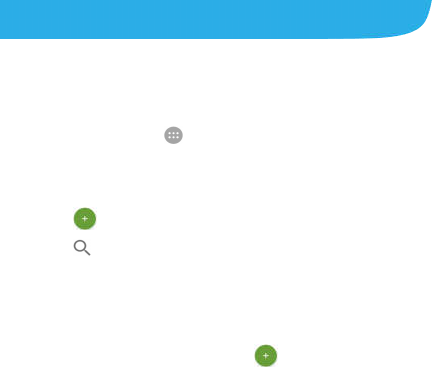
104
Messaging
You can use Messaging to exchange text messages (SMS) and
multimedia messages (MMS).
Opening the Messaging Screen
Touch the Home key > > Messaging.
The Messaging screen opens, where you can create a new
message, search for messages, or open an ongoing message
thread.
Touch to write a new text or multimedia message.
Touch to search for a message using keywords.
Touch an existing message thread to open the conversation
you’ve had with a certain number.
Sending a Message
1. On the Messaging screen, touch at the bottom right
corner.
2. Add recipients by one of the following ways.
Touch the To field and manually enter the recipient’s
number or the contact name. If the phone presents a few
suggestions, touch the one you want to add.
Select recipients from your contacts or history by
touching the FREQUENTS tab or the ALL CONTACTS
tab.

105
3. Touch the Send message field and enter the message text.
4. If you want to send a multimedia message, touch to
attach a file to the message. You can also add quick reply or
contact information to your text message.
Touch to capture a photo or record a video and add
it to the message.
Touch to select an existing image and add it to the
message.
Touch to add video, voice, contacts, quick reply,
other types of files, or record an audio clip and add to
the message.
5. Touch .
NOTE:
You can also include email addresses as recipients for a
multimedia message.
NOTE:
Do not add any attachment if you want to send a text message.
Otherwise you may be charged for a multimedia message.
Replying to a Message
Messages you receive are appended to existing threads of the
same number. If the new message comes from a new number,
a new thread is created.
1. On the Messaging screen, touch the thread that has the

106
message you want to reply to.
2. Type your reply in the text box at the bottom. You can touch
if you want to reply with an MMS.
3. Touch .
Forwarding a Message
1. On the Messaging screen, touch the thread that has the
message you want to forward.
2. Touch and hold the message and then touch at the top.
3. Touch an ongoing thread or touch if you want to send
the message to someone else.
4. Edit the content if you want.
5. Touch .
Deleting Messages or Threads
Delete a Message in a Thread
1. On the Messaging screen, touch a thread.
2. Touch and hold the message you want to delete.
3. Touch > DELETE.

107
Delete Message Threads
1. On the Messaging screen, touch and hold a thread you
want to delete.
2. If there are more threads you want to delete, touch them
one by one.
3. Touch > DELETE.
Changing Message Settings
Touch > Settings in the Messaging screen to change the
messaging settings.

108
Calendar
Calendar on the phone works with the web-based Google
Calendar™ service for creating and managing events,
meetings and appointments. It also works with the Microsoft
Exchange ActiveSync calendar once you sign into your
Exchange account on the phone.
To open Calendar, touch in the home screen and select
Calendar.
Viewing Your Calendars and Events
Select Visible Calendars
1. Open the Calendar app.
2. Touch > Calendars to display.
3. Touch the calendars to check the ones you want to see or
uncheck the ones you’d like to hide.
Events from hidden calendars are not shown in the Calendar
app.
Change Calendar Views
You can view your calendars in different forms. The app offers
four view types: Month, Week, Day, and Agenda.
To change calendar views, touch the current view at the top left
and select the view you prefer.

109
In Month view, swipe horizontally to see past and future
months.
In Week or Day view, swipe horizontally to see previous and
future weeks/days.
In Agenda view, swipe vertically to see all your events.
When you are viewing past or future days, weeks, or
months, touch the date icon at the top right to quickly switch
to today.
Touch > Go to date and touch a desired date to switch to
in calendar.
View Event Details
In Agenda, Day, or Week view, touch an event to view its
details.
In Month view, touch a day to view events on that day. Then
touch an event to view its details.
Creating an Event
1. In any Calendar view, touch at the bottom right.
You can also touch a spot in Day or Week view twice to add
an event to that time spot.
2. If you have more than one calendar account, touch the
current account above the Event name line to choose one.
3. Enter the event details and touch SAVE.
NOTE:

110
You can also create a new event by copying the details of an
existing event. Just open the event details screen and touch
> Copy. Then edit the new event information and touch
SAVE.
Editing, Deleting or Sharing an Event
1. Find the event you want to edit, delete or share.
2. Open its details screen (see View Event Details in this
chapter).
3. Do one of the following as you need.
To edit the event, touch . Touch SAVE to save your
changes.
To delete the event, touch > OK.
To share the event, touch and choose how to share.
Changing Calendar Settings
To change the calendar settings, open a calendar view (Day,
Week, Month, or Agenda), and touch > Settings.
You can change General settings, which apply to all accounts,
or other settings that only apply to specific accounts.

111
Web Browser
Use Browser to view web pages and search for information.
Opening the Browser
Touch the Home key > > Browser to launch the web
browser.
The browser also opens when you touch a web link - for
example, in an email or a text message.
1. Open the Browser app.
2. Touch the address box at the top.
3. Enter the address (URL) of a web page or enter terms you
want to search for.
4. Touch a URL or search suggestion or touch the enter key on
the keyboard to open the web page or search results.
Setting the Homepage
Your home page opens when you open a new browser tab, and
when you start Browser after restarting your phone.
1. Open the Browser app.
2. Touch > Settings > BASIC > Set homepage.
3. Enter the URL and touch OK to set it as the homepage.

112
Using Multiple Browser Tabs
You can open several web pages at the same time (one page in
each tab) and switch between them freely.
To open a new browser tab:
Touch > New tab. A new browser tab opens and the
homepage is loaded.
To switch between browser tabs:
1. Touch . Titles of opened tabs appear as a list.
2. Touch the title you want to open.
NOTE:
Swipe a title horizontally or touch its X to close the tab.
Downloading Files
1. Touch and hold an image or a link to a file or to another web
page.
2. In the menu that opens, touch Save image or Save link.
The downloaded files are saved to your phone. You can view or
open them in the Downloads app.
Changing Browser Settings
You can configure a number of settings to customize the way
you browse the web, including several that you can use to

113
control your privacy.
To open the Browser settings screen, touch > Settings in the
browser screen.
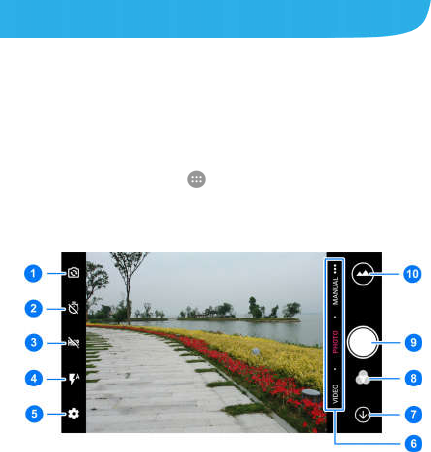
114
Camera
You can use your phone to take photos and record videos.
Photos and videos are stored on the microSDXC card you have
installed or in the phone storage. You can copy them to your
computer or access them in the Gallery app.
Capturing a Photo
1. Touch the Home key > > Camera.
2. Aim the camera at the subject and make any necessary
adjustment. PHOTO (auto camera) mode is used by default.
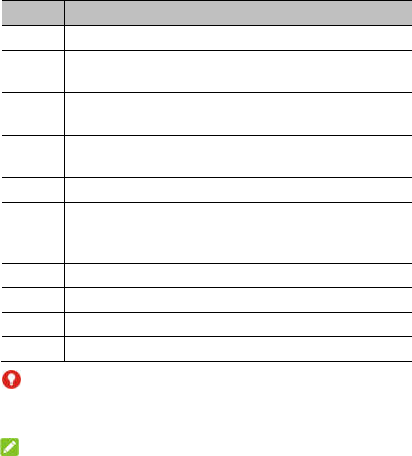
115
Number
Function
1 Switch between the front and back cameras.
2 Set a time delay before the camera takes a picture
automatically after you touch the shutter icon.
3 Turn on or off the HDR feature, only available for
the back camera.
4
Change the flash setting, only available for the back
camera.
5 Change the camera settings.
6
Switch among the default PHOTO mode, VIDEO
mode, MANUAL mode, and more (PANORAMA,
MULTI EXPOSURE, and TIMELAPSE).
7 Exit the camera.
8 Select a filter.
9 Capture a picture.
10 View pictures and videos you have taken.
WARNING!
Keep a safe distance when using the flash. Do not point the
flash towards the eyes of people or animals.
NOTE:
You can spread or pinch on the screen to zoom in or out
before taking pictures.
3. Touch the area where you want the camera to focus, or

116
leave the camera to autofocus on the center of the image.
NOTE:
In PHOTO (auto camera) mode, when you touch the screen
to focus, the exposure bar appears beside the focus
point. You can drag up or down to adjust the exposure.
4. Lightly touch to take a photo.
NOTE:
When you use the front camera, you can also touch or
to turn on or off smile detection.
Recording a Video
1. Touch the Home key > > Camera > VIDEO.
2. Aim the camera at the subject. You can touch any area on
the screen that you want the camcorder to focus on before
and during recording.
NOTE:
You can spread or pinch on the screen to zoom in or out
before and during recording.
NOTE:
When you touch the screen to focus during recording, the
exposure bar appears beside the focus point. You can

117
drag up or down to adjust the exposure. Touch and hold
the focus point to lock the focus.
3. Touch / to start / stop the recording. You can also
touch to pause the recording.
NOTE:
When the recording is in progress, touch to save the
frame as a separate photo.
Using Manual Camera Mode
You can use manual camera mode to adjust more camera
options for your photo such as ISO, white balance, exposure,
etc.
1. Touch the Home key > > Camera.
2. Touch MANUAL.
3. Aim the camera at the subject and you can make the
following adjustments.
Drag the green circle to any area on the screen that you
want to focus on. Touch and hold it to lock the focus.
Drag the yellow square to any area on the screen where
you want the camera to meter exposure so as to adjust
the photo brightness. Touch and hold the square to lock
exposure.
Touch to unfold the options, including ISO, overall
exposure, white balance and interval for time lapse

118
pictures. You can also touch one icon to unfold one
setting.
4. Touch the shutter icon to take the photo.
Using Other Camera Modes
Besides capturing photos and videos in the traditional way, your
camera app offers other powerful and interesting camera
modes. Touch in the viewfinder screen to find them all.
PANORAMA: Capture panorama pictures.
MULTI EXPOSURE: Capture two pictures for collage.
TIMELAPSE: Set the time interval between each frame
when you shot time lapse videos with the back camera.
Customizing Camera/Camcorder
Settings
Before capturing a photo or a video, you can touch to open
the following camera and camcorder options.
NOTE:
Some camera and video options will change in different camera
modes.
Options in photo mode
Resolution: Set the image size for your photo.
Tap to capture: Available for the front camera. When this
119
feature is enabled, you can touch the viewfinder screen to
take a photo using the front camera.
Mirror image: Available for the front camera. You can
enable this feature to take a mirror photo using the front
camera.
Selfie indicator: Available for the front camera. You can
enable this feature to capture natural expressions by
looking at the selfie indicator on the screen when taking a
selfie.
Metering: Adjust the metering setting.
Composition: Show or hide grid or golden spiral for
balanced photo composition.
Gradienter: Enable or disable the gradienter.
Shutter tone: Turn on or off the shutter tone.
Geo-tagging: Select whether to store the GPS location in
your captured photos and videos.
Auto review: Show the picture just captured.
Volume key: Assign the function of the Volume key.
Anti-banding: Set the anti-banding value when you take
pictures of TV or computer screens to avoid stripes on the
screen.
Save location: Change the storage location for captured
photos and videos when a microSDXC card is installed.
Help: View help details or enable help icon on the
viewfinder screen.
Restore defaults: Restore default camera and video
120
settings.
Options in video mode
Video quality: Set the quality for your video.
Shutter tone: Turn on or off the shutter tone.
Geo-tagging: Select whether to store the GPS location in
your captured photos and videos.
Anti-banding: Set the anti-banding value when you
record videos of TV or computer screens to avoid stripes
on the screen.
Save location: Change the storage location for captured
photos and videos when a microSDXC card is installed.
Help: View help details or enable help icon on the
viewfinder screen.
Restore defaults: Restore default camera and video
settings.

121
Gallery
Opening Gallery
Touch the Home key > > Gallery to view albums of your
pictures and videos.
Working With Albums
When you open Gallery, all pictures and videos on your phone
are displayed. Touch Timeline/Album to select view mode.
Timeline displays contents in chronological order and Album
displays in a number of albums.
To view album contents:
Touch an album to view the pictures and videos it contains.
To share albums, pictures, or videos:
1. Touch and hold an album to select it or touch and hold an
item after you open an album to select a picture or a video.
2. Touch more items that you want to share.
3. Touch and select how you want to share the items.

122
To delete albums, pictures, or videos:
1. Touch and hold an album to select it or touch and hold an
item after you open an album to select a picture or a video.
2. Touch more items that you want to delete.
3. Touch > OK.
To hide albums:
1. Touch and hold an album to select it.
2. Touch more albums that you want to hide.
3. Touch > OK.
NOTE:
To show the hidden albums again, touch > Settings >
Manage hidden albums. Touch the albums you want to restore
and touch Show at the bottom.

123
Working With Pictures
Touch a picture in an album to view the picture in full screen.
When viewing a picture in full screen, the following features are
available.
Swipe horizontally to see more pictures or videos.
Pinch a picture or video to make it smaller. You'll then see a
filmstrip-style view of all your pictures and videos in a row.
Swipe left or right to scan through them all.

124
NOTE:
You can delete a picture or video by swiping it up in the
filmstrip view. If you accidentally delete one, touch UNDO to
retrieve it.
Double-tap the picture, or pinch two fingers together or
spread them apart to zoom out or in.
Touch > OK to delete the picture.
Touch to edit the picture.
Touch to share the picture.
Touch to add the picture to the Favorite album.
Touch to rotate, rename, or print the picture, set it as
wallpaper or contact photo, check file details, or browse the
album contents in a slideshow.
NOTE:
Some options may not be available for certain albums or
pictures.
Retouching Your Pictures
You can edit any photos you took and some other pictures in
Gallery. The changed picture is saved in the same album as
the original image, which is not affected.
1. Touch > Photo Editor while viewing a picture in full
screen to open the Photo Editor interface.
NOTE:
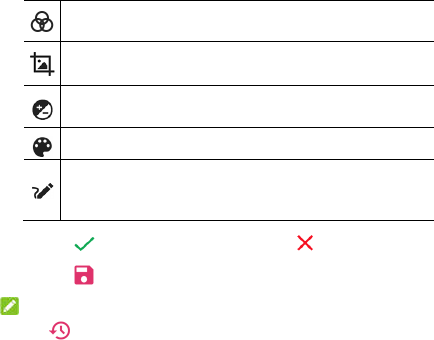
125
You can also choose to edit the picture with Photos.
2. Touch an edit option along the bottom of the screen and edit
the picture.
Apply filters, old photo effects or blur effects.
Crop, rotate, or flip (mirror) the picture.
Adjust exposure, contrast, sharpness, and other colour
options.
Adjust color of the picture.
Select a color and draw anything on the picture, or add
some text or mosaics to the picture and adjust the
effect.
3. Touch to keep the change or touch to cancel it.
4. Touch to save the new picture.
NOTE:
Touch in the Photo Editor screen to see the edits you have
made and undo or redo them.
Making a GIF Picture or a Collage
You can put together a few pictures in the same album to make
an animated GIF picture or a collage of pictures.

126
1. Open the Gallery app and touch > GIF maker or
Collage maker.
2. Touch an album.
3. Touch the pictures you need. You can exit the album and
open other albums to add more pictures.
To make a GIF, touch 2 to 50 pictures in the order or
reverse to the order that you want them to appear in the
GIF.
To make a collage, touch 2 to 9 pictures.
The pictures you touched are displayed along the bottom.
Touch to remove the pictures you do not need.
4. Touch NEXT. The GIF or collage is displayed.
5. Touch the options along the bottom to adjust the final
picture.
For GIF, you can adjust the speed, order and size, or
touch MORE to add more pictures to the GIF, change
their order, or adjust each picture.
For collage, touch TEMPLATE, FREE, or COLLAGE and
then select a border, shading or style.
6. When you are satisfied with the final picture, touch to
save the GIF or touch to save the collage.
Depending on your storage setting, the picture is saved to the
zte_editor/Save folder in your phone storage or your
microSDXC card.

127
Playing Videos
1. Touch an album in the gallery and then touch the thumbnail
of a video.
2. Touch at the center and select a player to start playing.
Touch the video to view the playback controls.

128
Music
Touch the Home key > > Music to play audio files stored
on your phone. Music supports a wide variety of audio formats,
so it can play music you purchase from online stores, music you
copy from your CD collection, and so on.
Viewing Your Music Library
Touch the Home key > > Music and your music library is
displayed. All your audio files are cataloged according to the
information stored in the files.
Touch All Songs to view all music files on your phone.
Touch Artists/Albums to browse music files on your phone
organized by the artist or album name.
Touch Folders to find music files through the folders they are
stored in.
Touch Favorites to browse music files you have marked as
favorites.
Touch Playlists to view all music playlists you have created.
NOTE:
If an audio file is being played, its name and player controls are
displayed at the bottom of the screen. Touch the area to open
the playback screen.
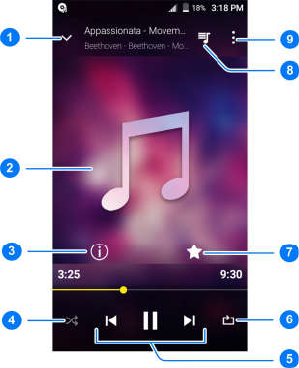
129
Playing Music
Touch a song in the music library to listen to it. Touch the
bottom of the screen to open the following playback screen.

130
Number
Function
1 Return to the music library.
2 Album artwork (if available). Slide left/right to switch to
the next/previous song in the playlist.
3 Check the track information.
4 Turn on or off shuffle.
5
Playback control: Skip songs or pause and resume
playback. Drag the progress bar to jump to any part of
the track.
6 Toggle repeat mode: no repeat, repeat the current
track, or repeat the current playlist.
7 Add the track to the Favorites playlist.
8 Touch to see the current playlist (queue).
9 Access additional options.
You can still control the music when you are not in the playback
screen.
In other apps, flick down the notification panel. Touch the
song title to restore the playback screen, or just pause/
resume playback or skip songs.
When the screen is locked, the song information, album
cover as well as playback control is displayed on the screen.
You can pause/resume playback or skip songs.

131
Managing Playlists
Create playlists to organize your music files into sets of songs,
so that you can play the songs you like in the order you prefer.
Touch > Add to playlist next to a song to add it to a
playlist or create a new playlist.
Touch > Delete/Rename next to a playlist to delete or
rename the playlist.
Touch a playlist to view its content. You can touch and hold
a song to select multiple songs for removal from the playlist.

132
Video Player
Use the Video Player app to manage your video library and
watch videos.
Opening the Video Library
Touch the Home key > > Video Player to view your video
library, where your video files are displayed in a list.
Swipe up or down to find the video you want. You can also
touch to search for video files, or touch > View by or
Sort by to change the display mode or sort the list.
Playing and Controlling Videos
Touch a video in the video library to play it. Touch the screen to
show the playback controls. You can control the video and
audio or carry out other operations.
Touch the play/pause button at the bottom to pause or
resume the playback.
Slide horizontally on the screen to rewind or fast forward.
Slide vertically on the right or left part of the screen to adjust
volume or brightness.
Touch or to skip to the previous or the next video.
Touch or to change the video ratio.

133
Touch to rotate the video.
Touch to capture a screenshot.
Touch to hide the control panel.
Touch to share, trim or delete the video, or configure
player settings.
Managing Video Files
Delete Video Clips
1. Touch and hold a video in the video library.
2. Check other videos you want to delete.
3. Touch
> OK.
Share Video Clips
1. Touch and hold a video in the video library.
2. Touch other videos you want to share.
3. Touch and select how you want to share them.
Trim a Video Clip
1. Touch a video to start playing it.
2. Touch > Trim.
3. Drag the two tabs on the progress bar to select the portion

134
you want to keep.
If necessary, touch to preview the selected portion.
4. Touch . The trimmed video is saved as a new video file.
NOTE:
You cannot trim the video during the preview.

135
FM Radio
With the FM radio, you can search for radio channels, listen to
them, and save them on your phone. Note that the quality of the
radio broadcast depends on the coverage of the radio station in
your area. The wired headset works as an antenna, so always
connect the headset when using the radio. When you receive
an incoming call while listening to the radio, the radio will be
turned off.
Scanning and Saving Channels
1. Plug in a wired headset and touch the Home key > >
FM Radio.
2. Touch > Scan. Your phone scans for available
channels and saves them to the All channels list.
NOTE:
When you open the FM Radio app for the first time, it will
automatically scan for channels and show the All channels list.
You can also touch > All channels to view the list.
Listening to FM Radio
1. Touch the Home key > > FM Radio while the headset
is connected.
2. Touch > All channels and select a channel.

136
You can also drag the frequency panel left or right, touch + or -,
or touch or to switch to other channels.
NOTES:
Touch to add the channel to favorites. Favorite
channels are put on the FM Radio main screen. Slide
up to view all favorite channels.
You can save at most 16 channels to favorites.
Touch to listen to the radio through the phone speaker.
Editing a Saved Channel
1. Open the FM Radio app and touch > All channels to
display the list of saved channels.
2. Touch and hold a channel and select Rename or Delete, or
touch the star to the right of a channel to add it to favorites.
Other Options and Settings
To turn off FM radio automatically:
Touch > Sleep Timer and select the time you want to turn off
the radio.
A count-down clock appears above the frequency and the radio
will be turned off when the clock counts down to 0:00.

137
To turn off FM radio immediately:
Touch the switch at the top of the screen.
To set your radio region:
FM radio frequency ranges differ in different regions.
Touch > FM frequency range to select the range you need.
NOTE:
If you change the frequency range, previously saved channels
are not shown until you switch back to the original frequency
range.

138
Sound Recorder
Sound Recorder enables you to record voice memos and
listen to them whenever you like.
Recording a Voice Memo
1. Touch the Home key > > Sound Recorder.
2. Touch the HQ icon to turn on or off high quality recording.
3. Touch to start recording. During recording, touch /
to pause or continue the recording.
4. Touch to stop recording. The memo is automatically
saved.
Playing a Voice Memo
To play a memo you just recorded:
Touch .
To play any saved memo:
1. Touch at the top right of the screen to see all
recordings.
2. Touch the title of a memo to play it.
NOTE:

139
Touch next to a memo to delete, share, rename, trim it,
add a tag, check its file information, or set it as your phone
ringtone or notification ringtone.

140
More Apps
Backup & Restore
Touch the Home key > > Backup & Restore. You can back
up your user data, such as messages and installed applications,
to the microSDXC card or phone storage regularly. If the data get
lost, restore it from the card or storage.
Touch > Help to view detailed guide.
Calculator
Touch the Home key > > Calculator to use the phone’s
convenient built-in calculator for some basic as well as advanced
mathematical equations.
NOTE:
Slide left while holding the phone upright, or hold the phone on its
side, to access advanced buttons.
Clock
Touch the Home key > > Clock. The Clock app allows you
to check local time in places around the world, set alarms, and
use timers.

141
Set a New Alarm
1. Touch the tab in the Clock app.
2. Touch an existing alarm to configure it, or touch at the
bottom of the screen to create a new alarm.
3. Set up the alarm options, such as time, alarm days, snooze,
alarm ringtone, and label.
4. Touch Save to save and exit.
NOTES:
To enable or disable existing alarms directly, just touch the
switches on the right side.
Touch in the tab to configure alarm settings,
including ringtone volume, vibration, alarm duration, volume
crescendo, and alarm in silent mode.
To change the default alarm ringtone, touch the Home key >
Settings > Sound > Default alarm ringtone.
Check World Time
Touch the tab in the Clock app to check local time around
the world.
Touch at the bottom to add a new city or country.
Use the Stopwatch and Countdown
Touch the or tab in the Clock app to use the stopwatch

142
or the countdown timer.
Stopwatch allows you to record lap times, while countdown
allows you to set a time and count down to zero.
Downloads
The Downloads app keeps a record of the files you have
downloaded using apps such as Browser or Email.
Touch the Home key > > Downloads to check the record.
Touch a file to open it with the appropriate applications.
Touch and hold a file to delete or share it.
File Manager
Quickly access all of your images, videos, audio clips, and other
types of files on your phone storage and the microSDXC card.
Touch the Home key > > File Manager.
Touch the CATEGORY tab to find the file you need by
category.
Touch the LOCAL tab to browse folders and files.
Touch and hold an item to access option icons such as
(Copy), (Move), (Share), or (Delete).
To copy or move an item, navigate to a new location and
touch PASTE.
Touch at the top right corner to create a new folder in

143
the current directory.
Touch to search for files.
Touch > View by or Sort by to change the view of the list
or the order of the items in the list.
Touch > Multi-Select to select multiple items for deletion,
sharing, copying, moving, or compression.
Touch > Show hidden files to display hidden system
files and folders.
Touch > Exit to exit the File Manager app.
Google Apps
Open the Google apps to use Google services.
NOTE:
Some contents or Google services may not be available in your
region.
Chrome: Use the Chrome app to browse the Internet and
get your bookmarks, browsing history, and more synced
with your Google account.
Drive: Store files on Google servers for free after you sign
in to your Google account. You can access them on your
computers, your phones and other devices, share them, or
collaborate with others.
Duo: Make a simple video calling which brings you
face-to-face with all the people that matter most.
144
Gmail: Send and receive emails via your Gmail account or
other personal email accounts.
Google: Use Google search or get information when you
need it with Google Now.
Keep: Create, share, and collaborate notes quickly and
easily.
Maps: Find your place and find your way in the world.
Photos: Manage photos on the phone and your Google
account.
Play Music: Play music on the phone and on your Google
account.
Play Store: Buy and download apps, games, and other
content from the Google Play Store.
Voice Search: Search for information with your voice.
YouTube: Watch video clips from YouTube.com, or upload
your own and share with the world.

145
Settings
Touch the Home key > > Settings. The Settings app
contains most of the tools for customizing and configuring your
phone.
At the top of the Settings screen, you can see setting
suggestions. Touch to check or customize the recommended
settings.
You can also swipe right from the left edge of most setting
screens to access the main settings quickly without going back
to the main settings screen by screen.
Wireless and Networks
Wi-Fi
Touch the Home key > > Settings > Wi-Fi. You can turn
Wi-Fi on or off and configure your Wi-Fi connections. See
Connecting to Wi-Fi.
When Wi-Fi is on, touch > Advanced > Wi-Fi Direct in the
Wi-Fi menu to share data between two devices via Wi-Fi
directly. See Using Wi-Fi Direct
®
.
Bluetooth
Touch the Home key > > Settings > Bluetooth. You can
turn Bluetooth on or off and configure your Bluetooth
connections. See Connecting to Bluetooth Devices.

146
Mobile Networks
Touch the Home key > > Settings > Mobile networks.
You can control mobile data, data roaming, network type,
network operator, and APNs. See Connecting to Mobile
Networks.
Mobile Hotspot
Touch the Home key > > Settings > Mobile hotspot to
share your phone’s mobile data connection with PCs or other
devices via Wi-Fi. See Sharing Your Mobile Data Connection as
a Mobile Hotspot.
Data Usage
Touch the Home key > > Settings > Data usage to check
and manage mobile data use. You can view and restrict Wi-Fi
data usage as well.
Touch Data saver to enable Data Saver which prevents
apps from using data connection in the background. For an
app you’re currently using, it can access data, but may do
so less frequently when Data Saver is enabled. You can
also touch Unrestricted data access and allow some apps
to always have access to data connection even when Data
Saver is turned on.
Touch the Cellular data switch to turn on or off mobile data.
Touch Cellular data usage to check how much data has
been used during the time cycle you set, see what apps

147
have been using mobile data, restrict background data for
individual apps, or allow unrestricted data usage when Data
Saver is on for individual apps.
Touch Billing cycle to set the reset date of the data usage
cycle, and set mobile data warning and limit.
Touch Wi-Fi data usage to view the Wi-Fi usage of apps.
Touch Network restrictions to select Wi-Fi networks that
are mobile hotspots. Apps may warn before using these
networks for large downloads to avoid high mobile data bills.
NOTE:
The data usage is measured by your phone, and your carrier’s
data usage accounting may differ.
Airplane Mode
Touch the Home key > > Settings > More and slide the
switch beside Airplane mode to turn airplane mode on or off.
All the phone’s radios that transmit voice or data are turned off
when airplane mode is on.
Enhanced LTE Services
Touch the Home key > > Settings > More and slide the
switch beside Enhanced LTE Services to enable or disable
HD voice and advanced communication services when 4G LTE
is available.

148
USB Tethering
Touch the Home key > > Settings > More > USB
tethering to share your phone’s mobile data connection with a
PC via USB so that you can access the Internet on the PC
using the phone. See Share Your Mobile Data Connection via
USB.
VPN
Touch the Home key > > Settings > More > VPN to set up
and connect to virtual private networks. See Connecting to
Virtual Private Networks.
Network Settings Reset
Touch the Home key > > Settings > More > Network
settings reset > RESET SETTINGS to reset all network
settings, including Wi-Fi, mobile networks, and Bluetooth.
Device
Display
Touch the Home key > > Settings > Display to configure
the following options.
Brightness level: Set the brightness of the display.
Adaptive brightness: Automatically adjust screen
brightness.
149
Wallpaper: Select a background image or animation for the
home screen or lock screen.
Battery percentage: Show or hide the battery percentage
next to the battery icon in the status bar.
Sleep: Set the length of time of inactivity before the screen
turns off automatically.
Press power button twice for camera: Launch the
camera app by pressing the Power key twice quickly, even
when the screen is locked.
Screen saver: Manage the screen saver function, which
can display colors or photos when the phone is docked or
charging.
Ambient display: Wake the phone from sleep when new
notifications arrive.
Font size: Set the font size of the text on the screen.
Display size: Adjust the display size of items including fonts,
icons and images on the screen.
When device is rotated: Select whether the screen
contents should rotate when the phone is rotated.
Pulse notification light: Flash the indicator light to notify
you of missed calls, new messages, and other events.
Navigation key light duration: This feature lets you control
the backlight of the touch keys (the Home key, the Back
key, and the Recent apps key). Choose one option to set
the backlight duration.

150
Notifications
Touch the Home key > > Settings > Notifications. You
can set different notification options for individual apps. Touch
an app to block or mute its notifications, select its notification
content to display on the lock screen, or let its notifications
override your Do No Disturb settings.
Sound
Touch the Home key > > Settings > Sound. You can
adjust different types of volume (see Adjusting Volume), set
notification mode (see Switching to Silent or Viration Mode), set
Do not disturb options (see Using Do Not Disturb Mode), set up
ringtone and notification sound (see Changing Ringtone and
Notification Sound), set up default alarm sound, or select
system sounds (see Turning On/Off System Sounds).
Apps
Touch the Home key > > Settings > Apps to see apps
installed on your phone and manage them.
Touch an app to see its information. The following options may
be available:
FORCE STOP: Stop the app.
UNINSTALL: Uninstall the app.
DISABLE/ENABLE: Disable or enable the app.
Storage: Check its storage information, clear its data or
cache.

151
Data usage: Check how much data has been used by the
app during the time cycle you set, restrict background data
for the app, or allow unrestricted data access when Data
Saver is on.
Permissions: Check or change the app permissions.
Notifications: Manage the app notifications in the
notification panel and the lock screen.
Open by default: Check the app’s supported links and set
whether to open the links in the app, and clear the app’s
defaults.
Battery: Check the battery use details of the app since last
full charge.
Memory: Check how much memory has been used by the
app.
Draw over other apps: Allow the app to display on top of
other apps that you’re using.
Modify system settings: Allow the app to modify system
settings.
NOTE:
Not all options are available for the apps.
Storage
Touch the Home key > > Settings > Storage to view the
memory information of the internal phone storage and the
microSDXC card.
You can choose the default location for new data, such as

152
photos captured and voice recorded. Touch Save location and
select to store items in the phone storage or the installed
microSDXC card.
Touch Phone > Used space to get a detailed breakdown of
space usage by type. Touch a data type to see more
information or delete the files you do not need.
For more information about using the internal storage and the
microSDXC card, see Using the microSDXC Card as Portable
or Phone Storage.
Battery
Touch the Home key > > Settings > Battery to view the
battery level, check what has been using the battery, and
optimize battery use.
Touch an app or service to adjust its settings in order to
save battery life. For example, touch Screen > Reduce the
screen brightness and/or screen timeout to change
screen brightness and sleep.
Touch Battery saver. You can turn on or off the Battery
saver or configure it to turn on automatically in order to
reduce battery use and improve battery life.
Touch > Battery optimization. Battery optimization
helps prolong battery standby time when you're not using
the phone. If there are apps that you don't want battery
optimization enabled, you can turn the feature off in those
apps. Just touch Not optimized > All apps, touch the app
name and then touch Don’t optimize > DONE.

153
Memory
Touch the Home key > > Settings > Memory to monitor
the average memory use and performance of your phone. You
can also check which apps use the most memory.
Call Settings
Touch the Home key > > Settings > Call settings to
configure call options. See Adjusting Your Call Settings.
Connect to PC
Touch the Home key > > Settings > Connect to PC to
select your USB connection type between your phone and PC.
See Connecting to Your Computer via USB.
Personal
Location
Touch the Home key > > Settings > Location to manage
location services, which help your phone and apps determine
your location. To use location-related applications, such as
finding your location on Google Maps, you must have location
services enabled on your phone.
1. Slide the switch at the top right to turn location services on or
off.
2. When location is enabled, touch Mode to select location

154
sources you want to use. To get your accurate location,
choose High accuracy. To save battery power and get
approximate location, choose Battery saving. To use only
GPS to pinpoint your location, choose Device only.
NOTE:
Touch Accelerated Location or Google Location History to
use Qualcomm
®
IZat™ hardware accelerated location to
determine your location or configure Google location options.
Security
Touch the Home key > > Settings > Security to configure
options that help keep your phone and data safe.
Screen lock: Disable the screen lock or enable it with long
press, pattern, PIN, or password. See Protecting Your
Phone With Screen Locks.
Touch beside Screen lock to set the following options.
Make pattern visible: Show the pattern as you draw it.
This option is available when unlock pattern is set.
Automatically lock: Set the time needed for the lock
protection to be activated after the screen turns off. This
option is available when unlock pattern, PIN or
password is set.
Power button instantly locks: Lock protection is
activated immediately when you press the Power key.
This option is available when unlock pattern, PIN or
password is set.

155
Lock screen message: Set the text that you may
display on the lock screen.
Smart Lock: Keep the phone unlocked when connected to
trusted devices, in trusted places, or unlocked by trusted
faces or voice, or unlocked when your phone is being
carried on the body.
NOTE:
You need to sign in to your Google account on the phone to
use the Smart Lock feature.
Encrypt phone: Encrypt your data on the phone to protect
your privacy. See Protecting Your Phone With Encryption.
Set up SIM card lock:
Lock SIM card: Activate or deactivate the PIN lock to
require PIN before accessing the nano-SIM card.
Change SIM PIN: Change the PIN used to access the
nano-SIM card.
NOTE:
Put all your confidential passwords in a safe place for future
use. If you enter the wrong SIM PIN more times than
allowed, your nano-SIM card will be locked and you cannot
access the mobile phone network. Contact your operator for
a PIN Unlock Key (PUK) to restore the nano-SIM card.
Make passwords visible: Display passwords as you enter
them.
Device administrators: View or deactivate apps you have
authorized to be device administrators.

156
Unknown sources: Switch on this option to permit
installation of apps from sources other than the Play Store.
Storage type: Check the credential storage type.
Trusted credentials: Display trusted CA certificates.
User credentials: View and modify stored credentials.
Install from SD card: Install certificates from the internal
storage or the microSDXC card.
Clear credentials: Delete all certificates.
Trust agents: View or deactivate trust agents.
Screen pinning: Keep a screen of your choice in view, so
that others cannot switch to other apps and access your
personal information. Touch this option to see how it works.
See Protecting Your Phone With Screen Pinning.
Apps with usage access: Turn on or off some apps’
access to your phone usage information.
Accounts
Touch the Home key > > Settings > Accounts to manage
your web accounts and synchronization. Touch Add account to
sign in to or create accounts on your phone.
Touch an account type to see that type of accounts you have
added and adjust the accounts settings.
Google
Touch the Home key > > Settings > Google to easily

157
manage settings for Google apps and features. You can set the
options for Google account and services.
Languages and Input
Touch the Home key > > Settings > Languages & input
to configure options related to system language, input methods,
speech input and output as well as mouse/trackpad input.
Languages: Select a language for your system.
Spell checker: Use Google Spell Checker to check for
spelling errors when entering text.
Personal dictionary: Add new words to the phone’s
dictionary or remove words from the dictionary. The words
you add are used for spelling check and word suggestion.
Virtual keyboard: Configure onscreen input method
settings. See Input Method Settings.
Physical keyboard: Configure options for physical
keyboard connected with your phone.
Text-to-speech output: Select the speech synthesis
engine or change its settings, set speech rate and pinch,
play a brief sample of the speech synthesizer, and check
whether the text-to-speech output feature supports the
current system language.
Pointer speed: Select how fast the pointer/mouse should
scroll when you connect the phone to a trackpad or mouse
accessory.

158
Navigation Key
Touch the Home key > > Settings > Navigation key to
swap the positions of the Back key and the Recent apps key.
Select an option to make the switch.
Backup and Reset
Touch the Home key > > Settings > Backup & reset to
manage data backup and restoration options, and to reset the
network setting or the phone to factory status.
Back up my data: Back up app data, Wi-Fi passwords, and
other settings to Google servers after you sign in to your
Google account.
Backup account: Set the Google account that the data is
backed up to.
Automatic restore: Restore previously backed up settings
and data when you reinstall an app.
Factory data reset: Reset your phone to factory default
settings. All your data in the internal storage will be erased
during the process. You can also erase the data on the
microSDXC card.
System
Date and Time
Touch the Home key > > Settings > Date & time to set

159
date, time, time zone, and the time format. You can also use
network-provided data.
Accessibility
Touch the Home key > > Settings > Accessibility to
configure accessibility plug-ins and services on your phone,
such as using Color inversion or Font size for users with sight
problems.
Printing
Touch the Home key > > Settings > Printing to manage
Google Cloud Print service or other printer plug-ins installed
from the Google Play Store or your printer manufacturer.
Cricket Software Update
Touch the Home key > > Settings > Cricket Software
Update to check for phone software updates and download
them when they are available.
About Phone
Touch the Home key > > Settings > About phone to view
the phone status, legal information and other information. You
can also touch Additional system updates to update the
phone software from update packages copied to the storage
card.

160
Upgrading the Phone Software
There are several ways to upgrade your phone software:
1. Use the online upgrade tool for mobile terminal products.
2. Use the one-press upgrade package offered by your mobile
service provider.
3. Use your PC to download an upgrade package to your
microSDXC card and install it to your phone from the card.
NOTE:
Visit the ZTE official handset service support website
(http://www.ztedevice.com/support) and click your country or
region to learn more about the above upgrade methods, as well
as which phones and methods are supported.

161
Troubleshooting
If you encounter problems while using the phone, or if it
performs abnormally, you can refer to the chart below. If your
particular problem cannot be resolved using the information in
the chart, contact the dealer where you purchased the phone.
Problem Possible causes Possible solution
Poor
reception
The network signal is
too
weak at your current
location, for example, in
a basement or near a
tall building, because
wireless transmissions
cannot effectively reach
it.
Move to a location
where the network
signal can be properly
received.
The network is busy at
the current time (for
example, during peak
times, there may be too
much network traffic to
handle additional calls).
Avoid using the phone at
such times, or try again
after waiting a short
time.
You are too far away
from a base station for
your service provider.
You can request a
service area map from
your service provider.

162
Problem Possible causes Possible solution
Echo or
noise
The network link quality
is poor on the part of
your service provider.
End the call and dial
again. You may be
switched to a
better-quality network
link or phone line.
The quality of the phone
line that you are calling
is poor
End the call and dial
again. You may be
switched to a
better-quality network
link or phone line.
Unable to
select
certain
features
Your service provider
does not support these
features, or you have not
applied for services that
provide these features.
Contact your service
provider.
Cannot
charge the
battery
The battery or battery
charger is damaged. Contact the dealer.
The phone’s temperature
is below 0 °C or higher
than 45 °C.
Adjust the battery
charging environment to
avoid extremes of
temperature.
The contact between the
battery and charger is
poor.
Check all connectors to
ensure that all
connections have been
properly made.

163
Problem Possible causes Possible solution
Shortened
standby time
The standby time is
related to your service
provider system
configuration. The same
phone used with
different service
providers’ systems will
not provide exactly the
same length of standby
time.
If you are located in an
area where signaling is
weak, temporarily power
off the phone.
The battery is depleted.
In
high temperature
environments, battery
life will be shortened.
Contact the dealer to
change a new battery.
If you are not able to
connect to the network,
the phone will continue
to send out signals as it
attempts to locate a
base station. Doing so
consumes battery power
and will consequently
shorten standby time.
Change your location to
one where the network
is accessible, or
temporarily turn off your
phone.

164
Problem Possible causes Possible solution
Cannot turn
your phone
on
Battery power has been
depleted.
Recharge the phone’s
battery.
nano-SIM
card error
The nano-SIM card
malfunctions or is
damaged.
Take the nano-SIM card
to your service provider
for testing.
The nano-SIM card is
inserted improperly.
Insert the nano-SIM
card properly.
There is debris on the
nano-SIM card contacts.
Use a soft, dry cloth to
clean the nano-SIM
card
contacts.
Unable to
connect to
the network
The nano-SIM card is
invalid.
Contact your service
provider.
You are not within the
network’s service area.
Check the service area
with your service
provider.
The signal is poor.
Move to an open space,
or if you are inside a
building, move closer to
a window.
Cannot
answer
incoming
calls
You have activated the
Call blocking feature.
Disable this feature.
See
Set Call Blocking.

165
Problem Possible causes Possible solution
Cannot
make
outgoing
calls
You have activated the
Fixed dialing numbers
feature.
Disable this feature.
See
Use Fixed Dialing
Numbers.
PIN Code
blocked
You have entered an
incorrect PIN code three
consecutive times.
Contact your service
provider. If the service
provider provides the
nano-SIM card’s PUK
code, use the PUK code
to unlock the nano-SIM
card.
Phone
crashes,
reboots,
freeze, or
cannot be
powered on
Some third-party
software is not
compatible with your
phone.
Uninstall the software
that may cause the
problem.
Upgrade the phone
software.
Reset the phone to
factory status.
FCC Regulations:
This mobile phone complies with part 15 of the FCC
Rules. Operation is subject to the following two
conditions: (1) This device may not cause harmful
166
interference, and (2) this device must accept any
interference received, including interference that may
cause undesired operation.
This mobile phone has been tested and found to
comply with the limits for a Class B digital device,
pursuant to Part 15 of the FCC Rules. These limits
are designed to provide reasonable protection
against harmful interference in a residential
installation. This equipment generates, uses and can
radiated radio frequency energy and, if not installed
and used in accordance with the instructions, may
cause harmful interference to radio communications.
However, there is no guarantee that interference will
not occur in a particular installation If this equipment
does cause harmful interference to radio or television
reception, which can be determined by turning the
equipment off and on, the user is encouraged to try to
correct the interference by one or more of the
following measures:
-Reorient or relocate the receiving antenna.
-Increase the separation between the equipment and
receiver.
-Connect the equipment into an outlet on a circuit
167
different from that to which the receiver is connected.
-Consult the dealer or an experienced radio/TV
technician for help.
FCC Note:
Caution: Changes or modifications not expressly
approved by the party responsible for compliance
could void the user‘s authority to operate the
equipment.
RF Exposure Information (SAR)
This phone is designed and manufactured not to
exceed the emission limits for exposure to radio
frequency (RF) energy set by the Federal
Communications Commission of the United States.
During SAR testing, this device was set to transmit at
its highest certified power level in all tested frequency
bands, and placed in positions that simulate RF
exposure in usage against the head with no
separation, and near the body with the separation of
15 mm. Although the SAR is determined at the
highest certified power level, the actual SAR level of
the device while operating can be well below the
168
maximum value. This is because the phone is
designed to operate at multiple power levels so as to
use only the power required to reach the network. In
general, the closer you are to a wireless base station
antenna, the lower the power output.
The exposure standard for wireless devices
employing a unit of measurement is known as the
Specific Absorption Rate, or SAR.
The SAR limit set by the FCC is 1.6W/kg.
This device is complied with SAR for general
population /uncontrolled exposure limits in
ANSI/IEEE C95.1-1992 and had been tested in
accordance with the measurement methods and
procedures specified in IEEE1528.
The FCC has granted an Equipment Authorization
this model phone with all reported SAR levels
evaluated as in compliance with the FCC RF
exposure guidelines. SAR information on this model
phone is on file with the FCC and can be found under
the Display Grant section of
169
after searching on
FCC ID: SRQ-Z852.
For this device, the highest reported SAR value for
usage against the head is 0.57 W/kg, for usage near
the body is 1.11 W/kg.
While there may be differences between the SAR
levels of various phones and at various positions,
they all meet the government requirements.
SAR compliance for body-worn operation is based
on a separation distance of 15 mm between the unit
and the human body. Carry this device at least 15
mm away from your body to ensure RF exposure
level compliant or lower to the reported level. To
support body-worn operation, choose the belt clips or
holsters, which do not contain metallic components,
to maintain a separation of 15 mm between this
device and your body.
RF exposure compliance with any body-worn
accessory, which contains metal, was not tested and
certified, and use such body-worn accessory should
170
be avoided.
Hearing aid compatibility (HAC)
regulations for mobile phones
In 2003, the FCC adopted rules to make digital wireless
telephones compatible with hearing aids and cochlear implants.
Although analog wireless phones do not usually cause
interference with hearing aids or cochlear implants, digital
wireless phones sometimes do because of electromagnetic
energy emitted by the phone's antenna, backlight, or other
components. Your phone is compliant with FCC HAC regulations
(ANSI C63.19- 2011). While some wireless phones are used near
some hearing devices (hearing aids and cochlear implants),
users may detect a buzzing, humming, or whining noise. Some
hearing devices are more immune than others to this interference
noise and phones also vary in the amount of interference they
generate. The wireless telephone industry has developed a
rating system for wireless phones to assist hearing device users
in finding phones that may be compatible with their hearing
devices. Not all phones have been rated. Phones that are rated
have the rating on their box or a label located on the box. The
ratings are not guarantees. Results will vary depending on the
user's hearing device and hearing loss. If your hearing device
happens to be vulnerable to interference, you may not be able to
use a rated phone successfully. Trying out the phone with your
hearing device is the best way to evaluate it for your personal
needs.
This phone has been tested and rated for use with hearing aids
171
for some of the wireless technologies that it uses. However, there
may be some newer wireless technologies used in this phone
that have not been tested yet for use with hearing aids. It is
important to try the different features of this phone thoroughly and
in different locations, using your hearing aid or cochlear implant,
to determine if you hear any interfering noise. Consult your
service provider or the manufacturer of this phone for information
on hearing aid compatibility. If you have questions about return or
exchange policies, consult your service provider or phone retailer.
M-Ratings: Phones rated M3 or M4 meet FCC requirements and
are likely to generate less interference to hearing devices than
phones that are not labeled. M4 is the better/higher of the two
ratings.
T-Ratings: Phones rated T3 or T4 meet FCC requirements and
are likely to be more usable with a hearing device’s telecoil (“T
Switch” or “Telephone Switch”) than unrated phones. T4 is the
better/higher of the two ratings. (Note that not all hearing devices
have telecoils in them.)
Your phone meets the M4/T3 level rating.
Hearing devices may also be rated. Your hearing device
manufacturer or hearing health professional may help you find
this rating. For more information about FCC Hearing Aid
Compatibility, please go to http://www.fcc.gov/cgb/dro.
172